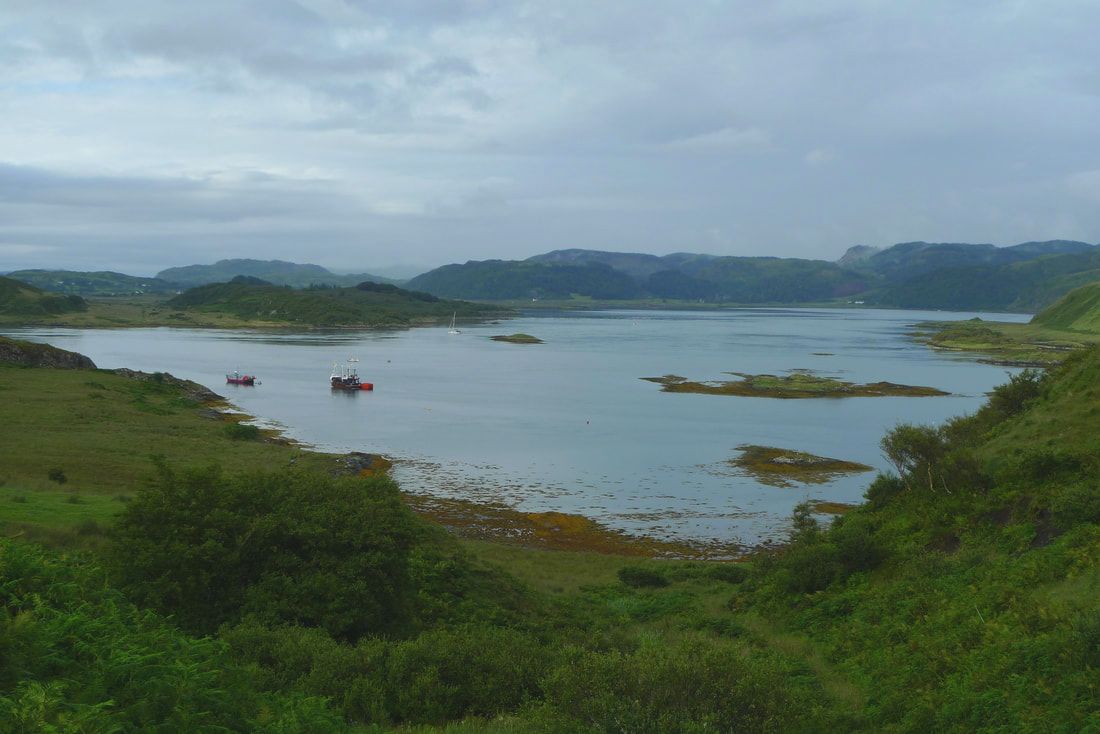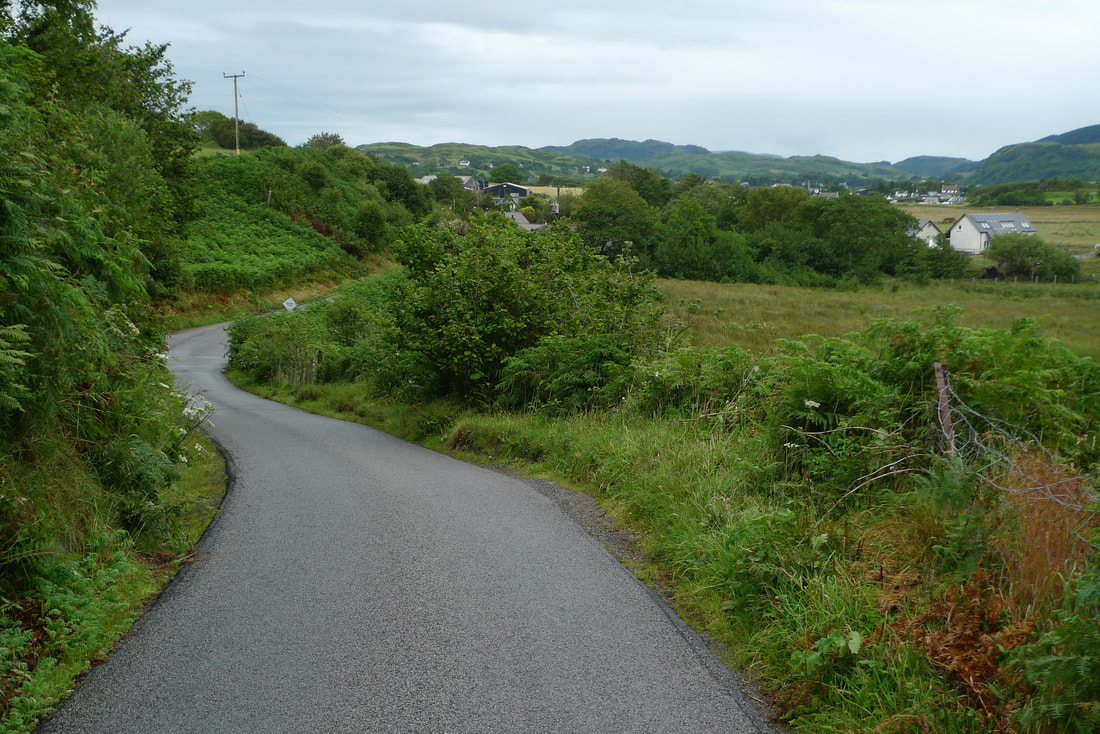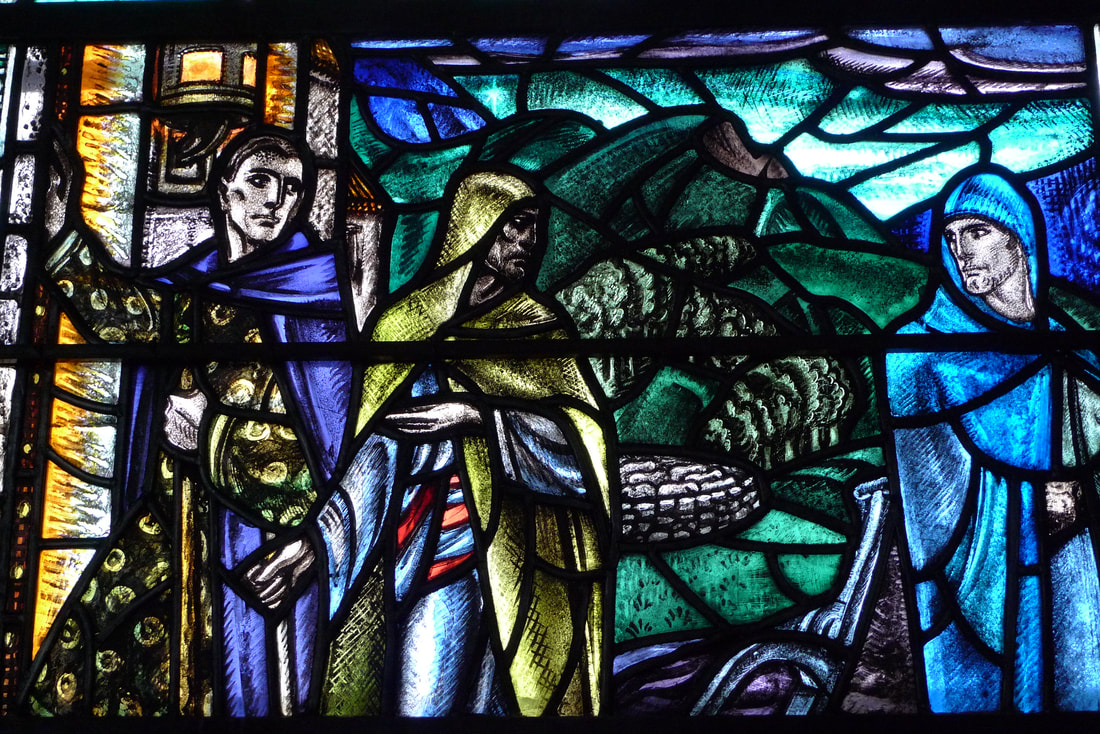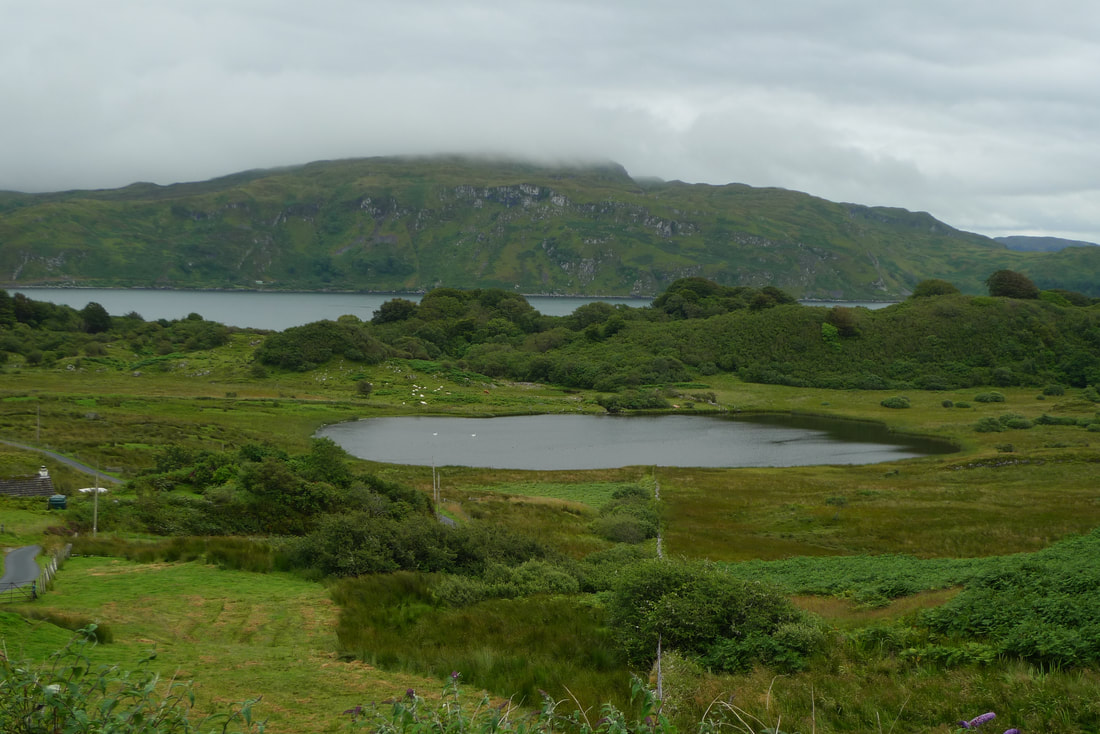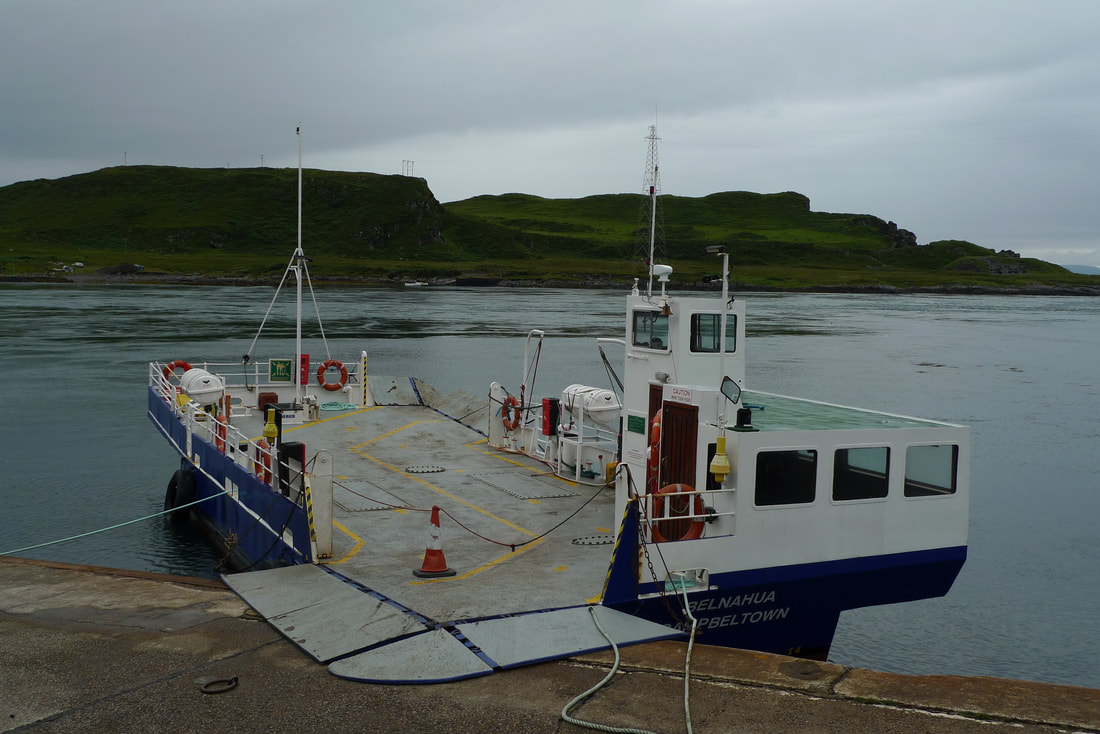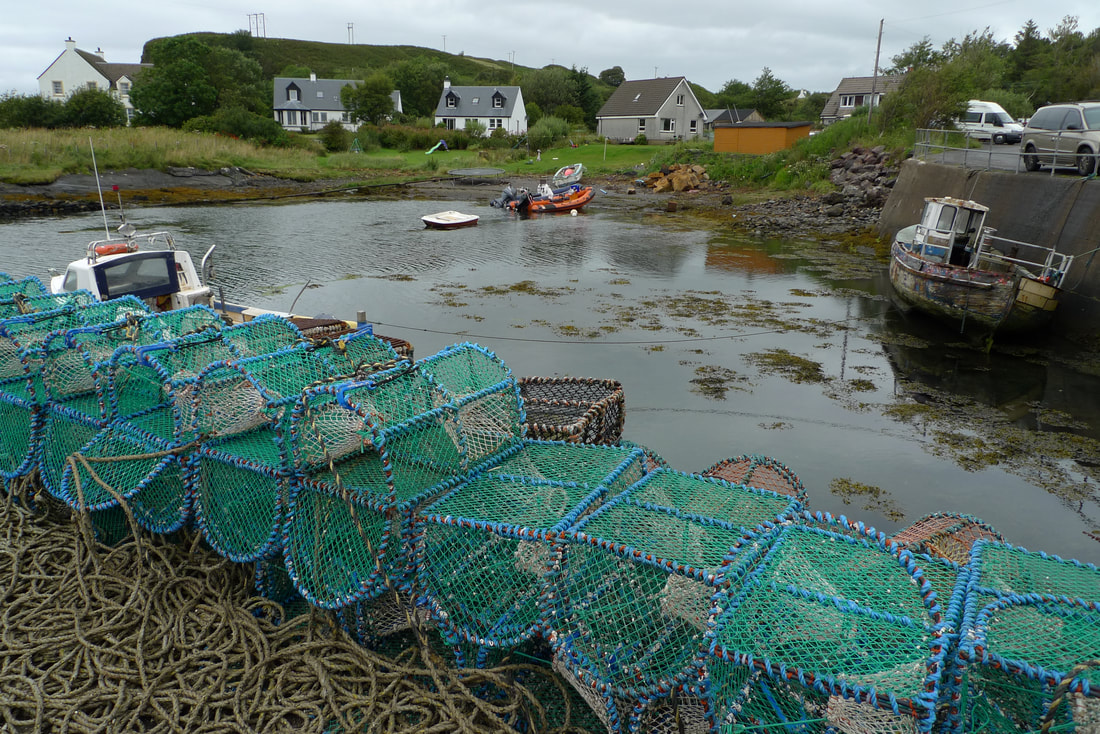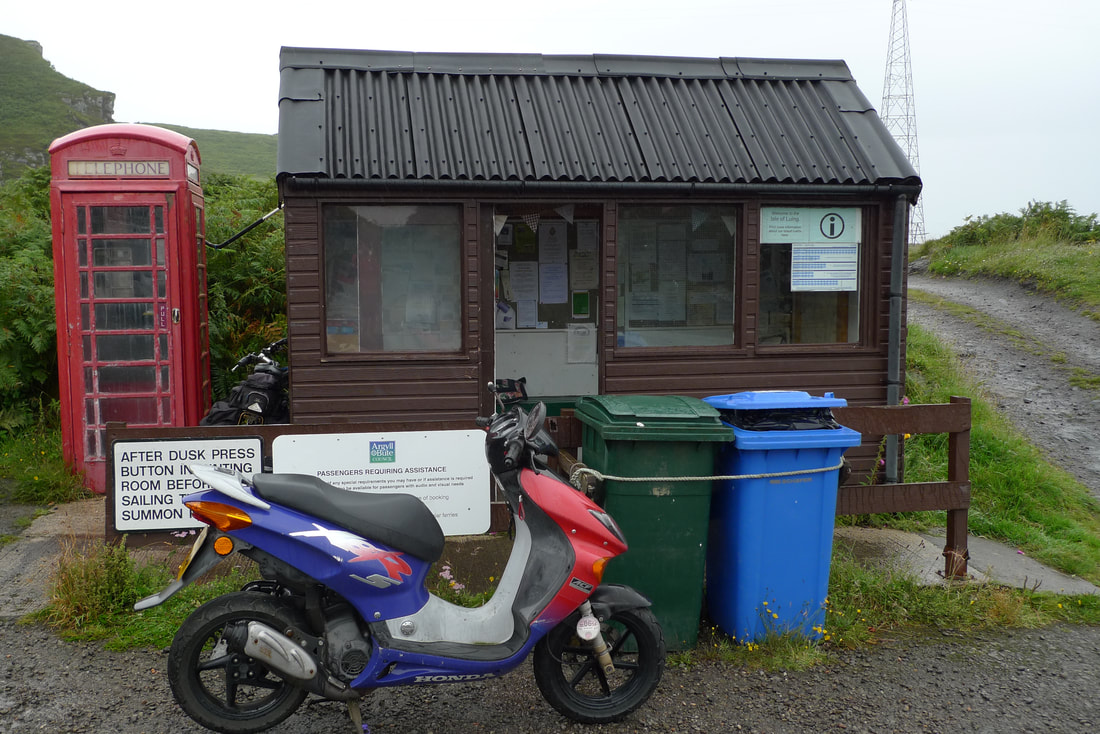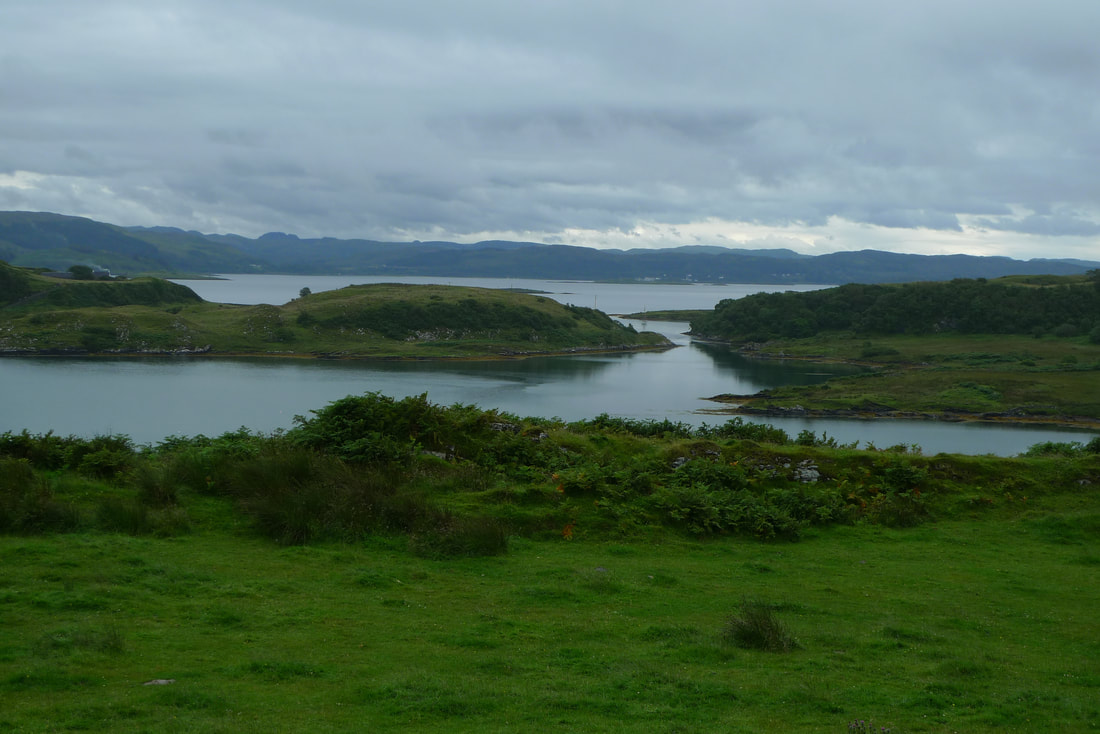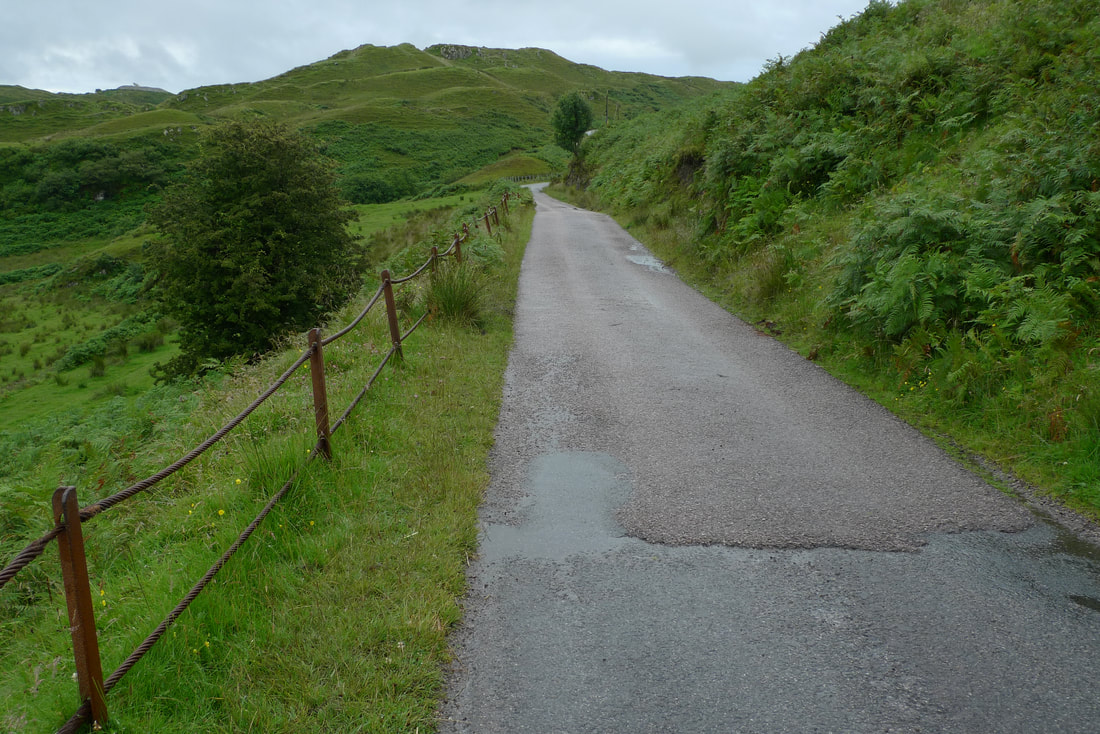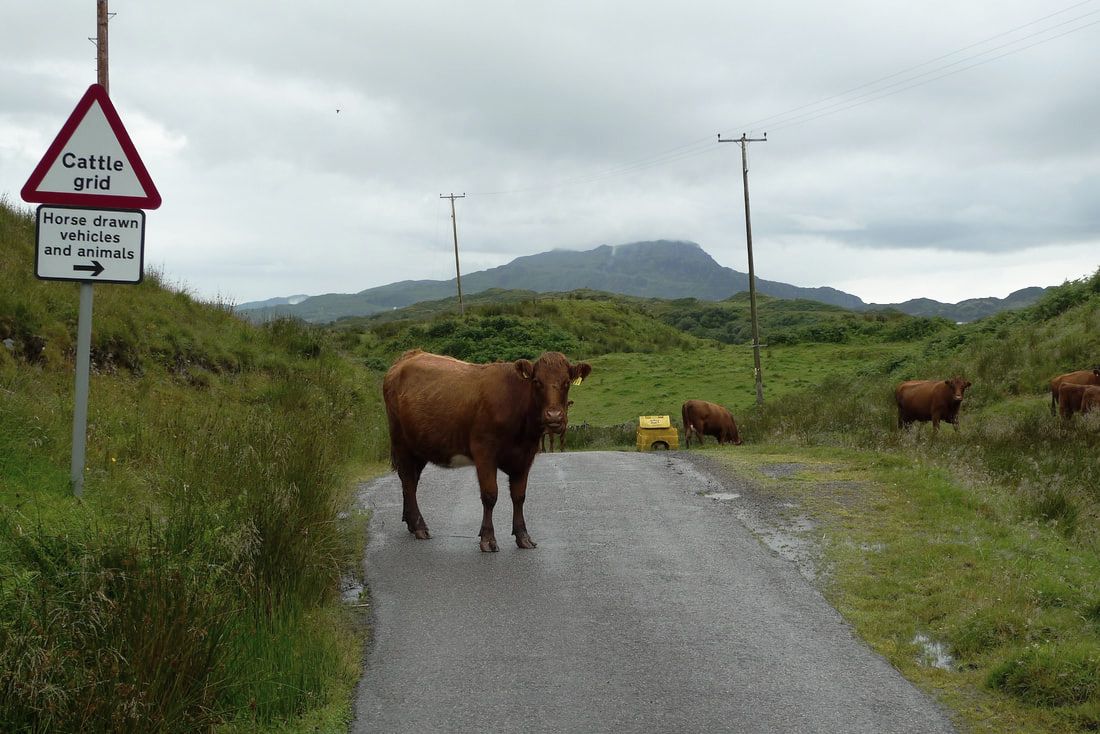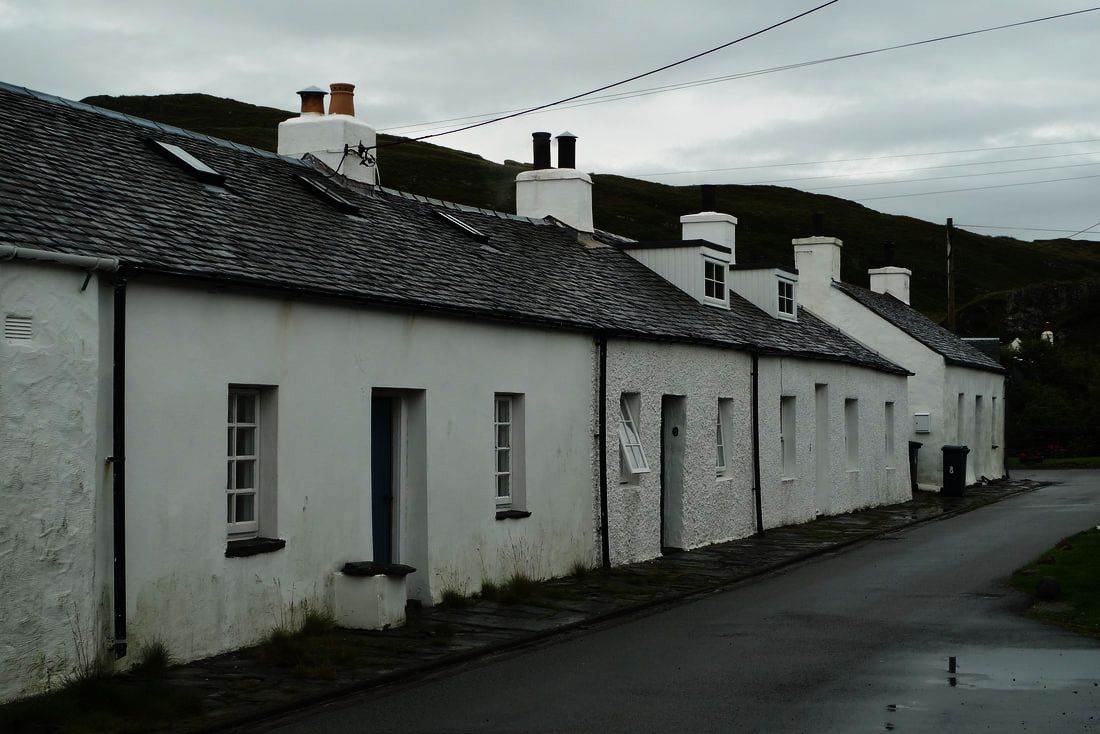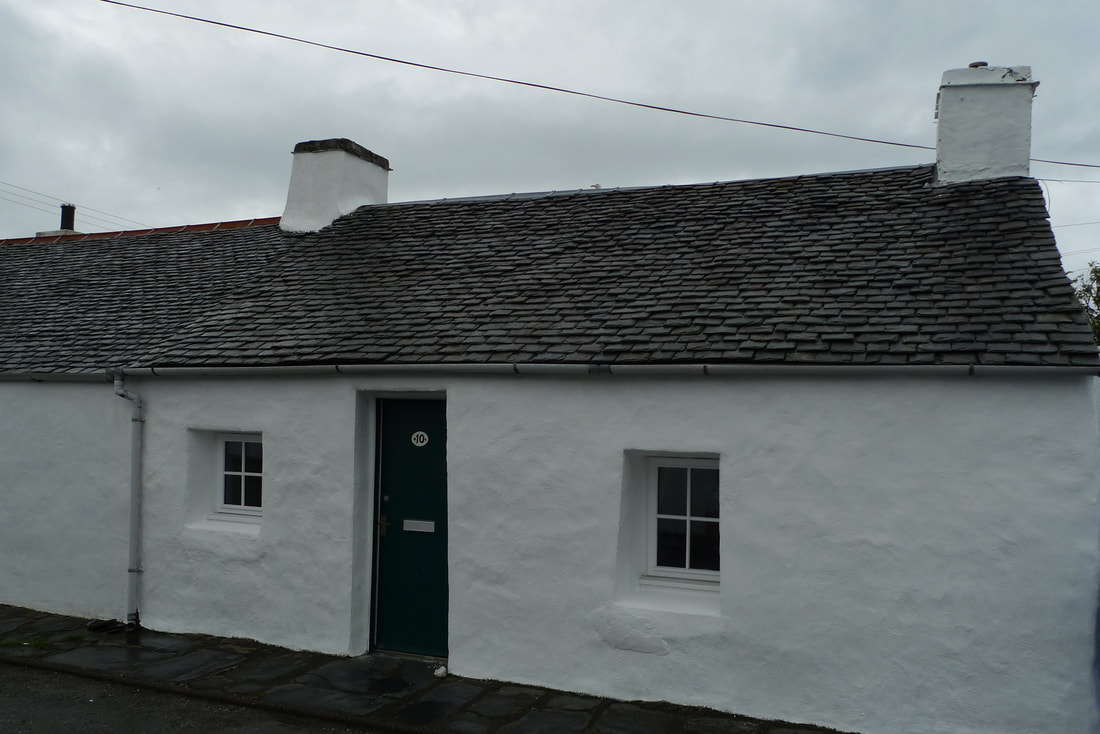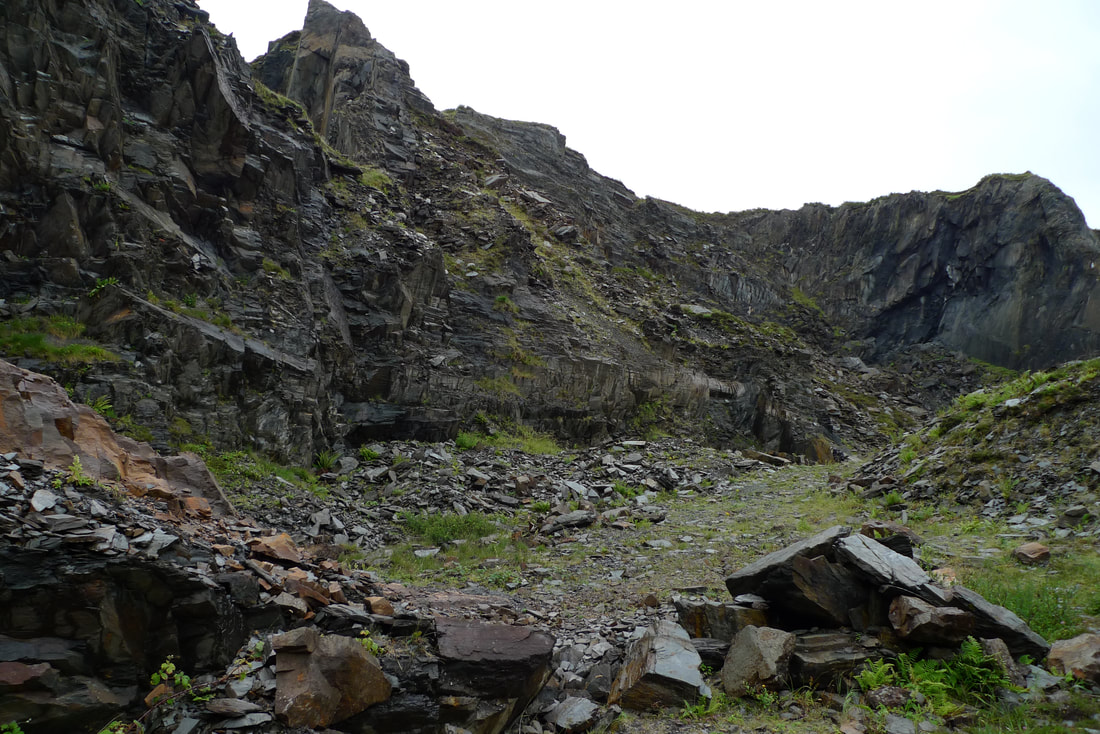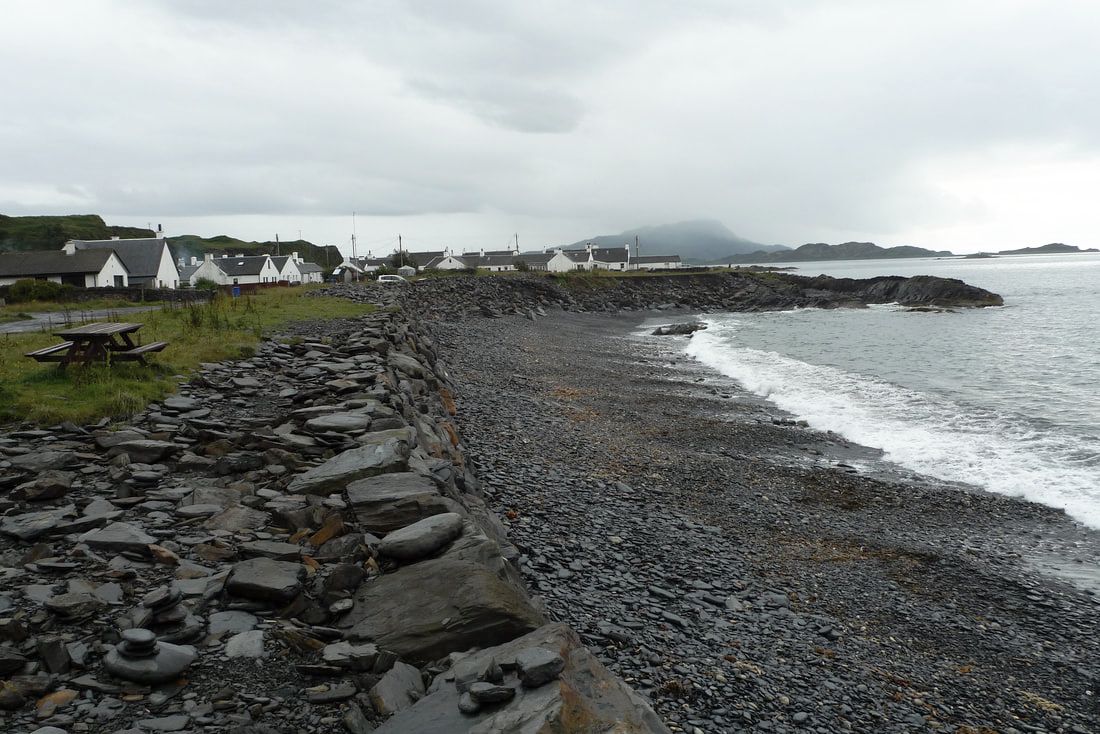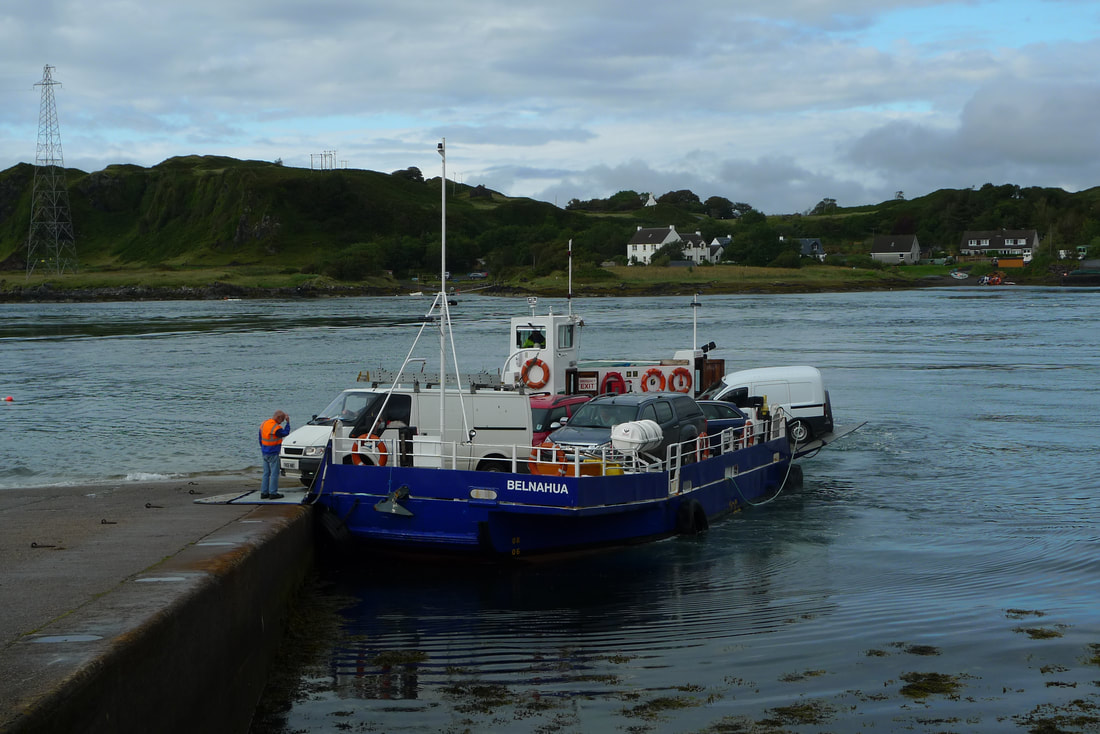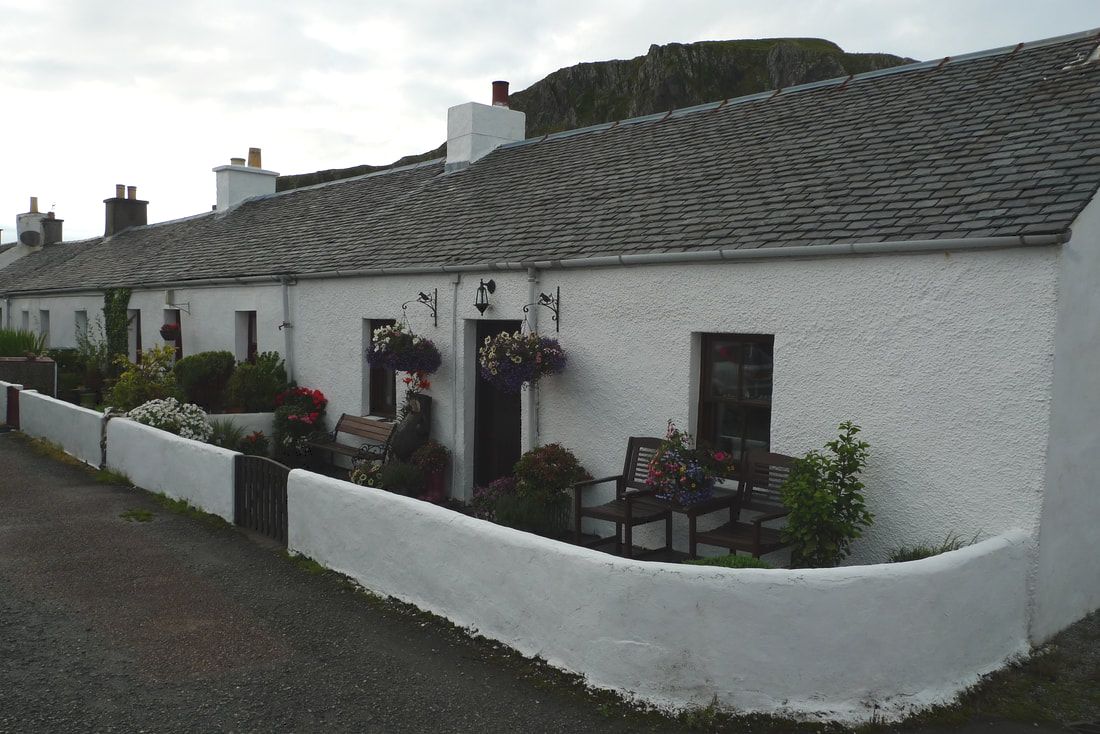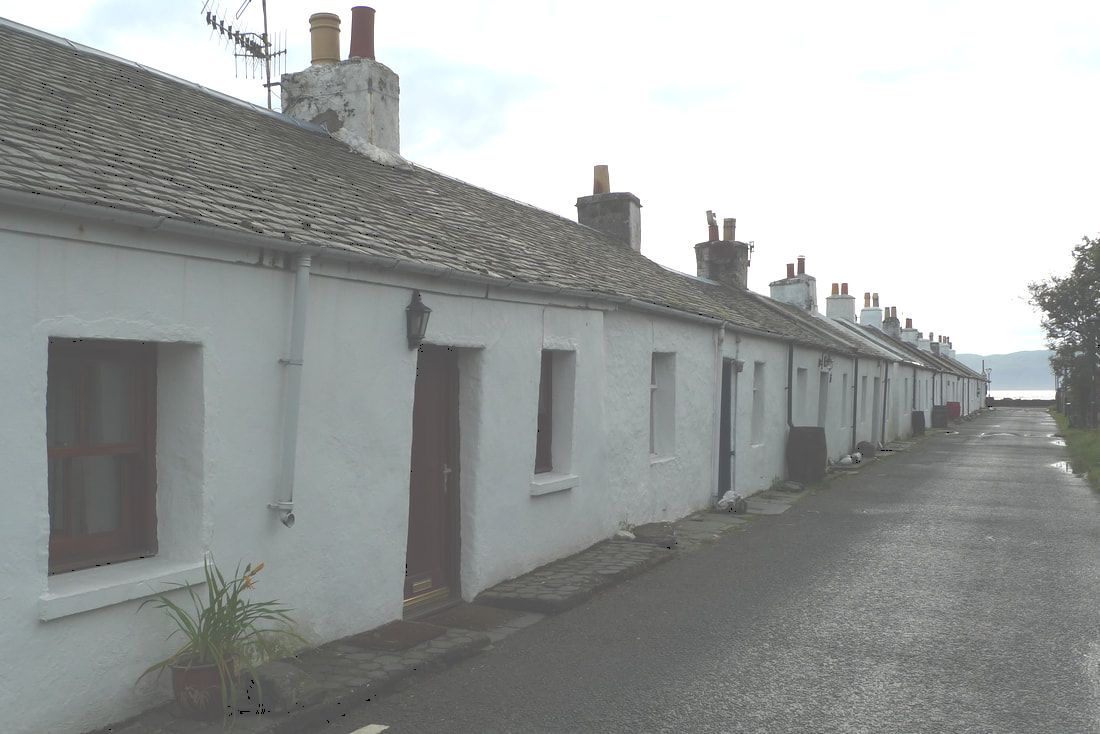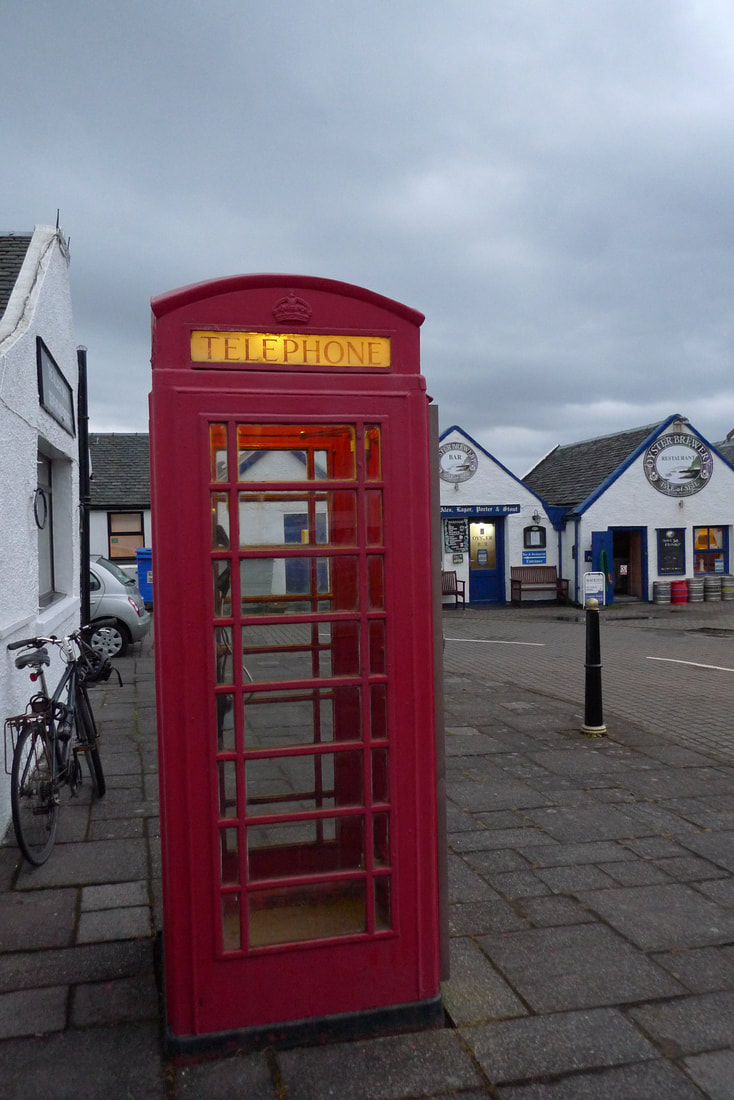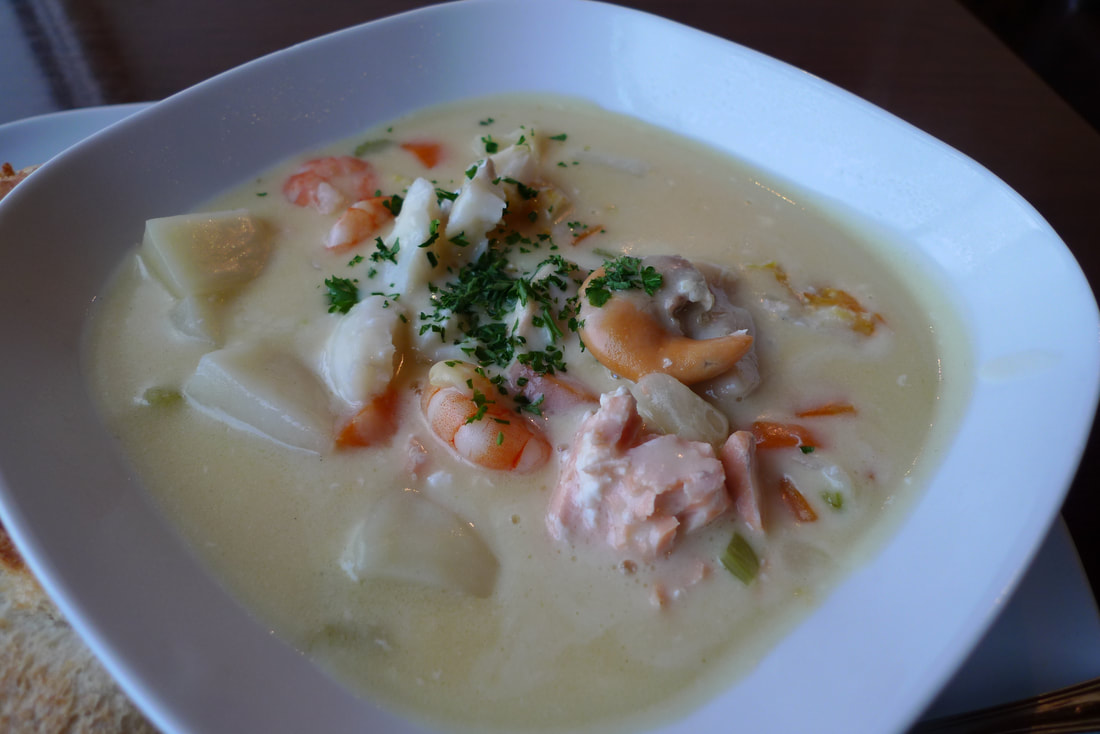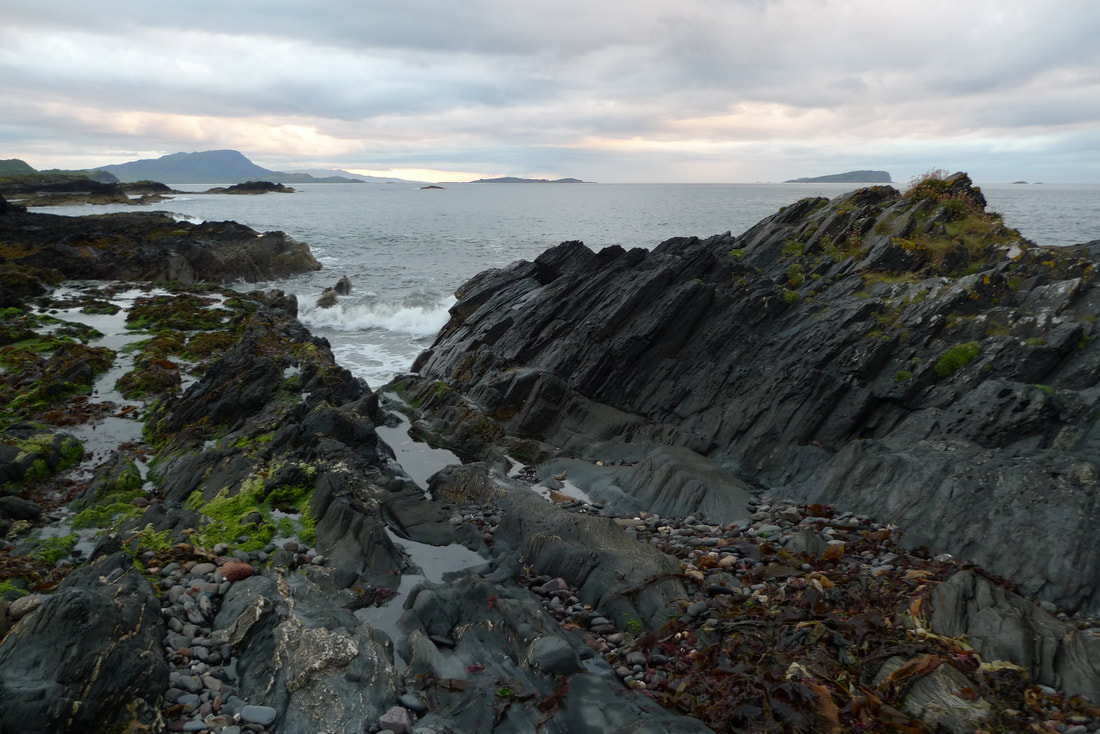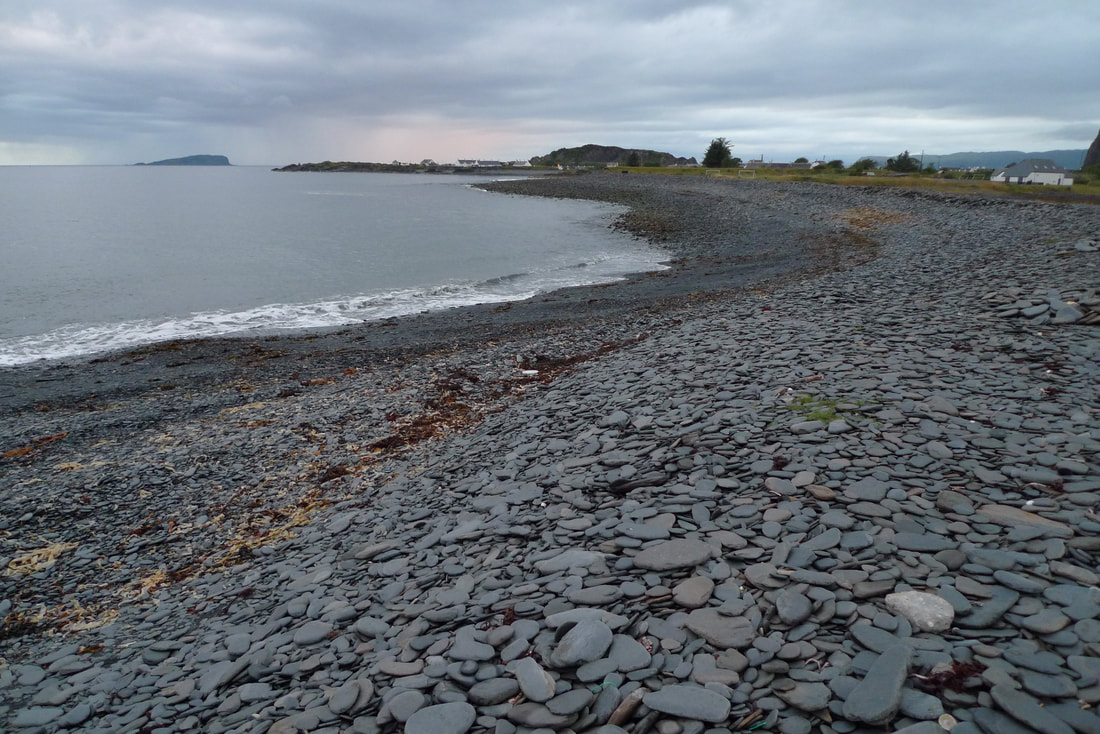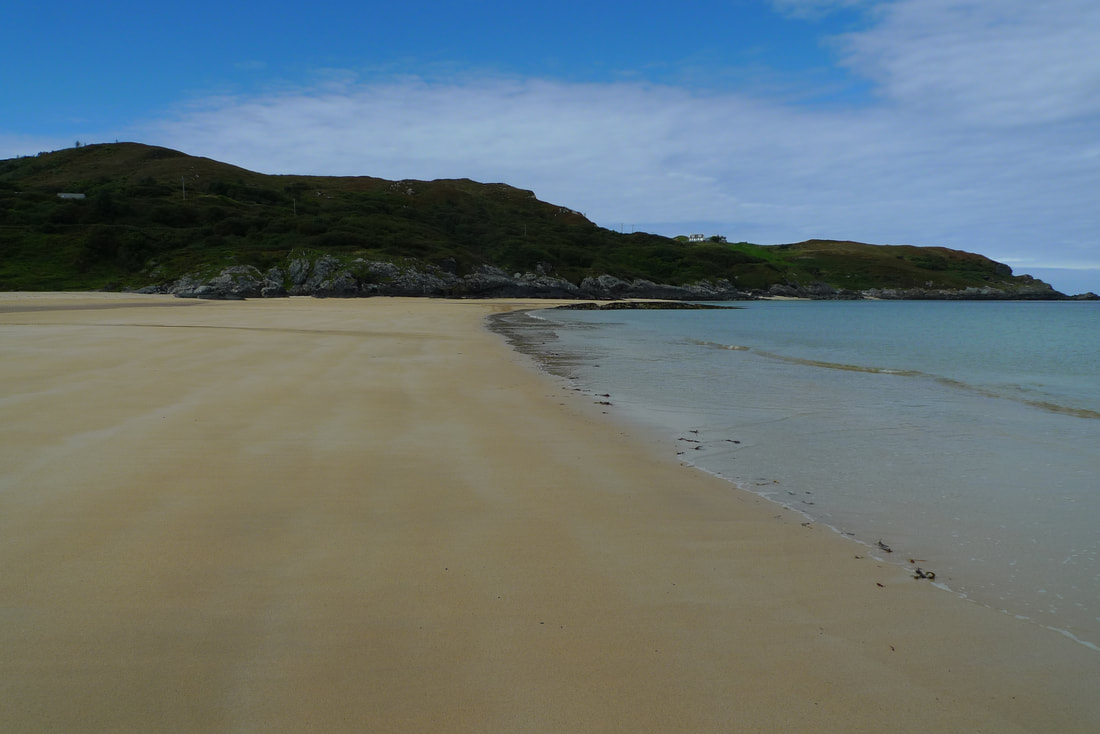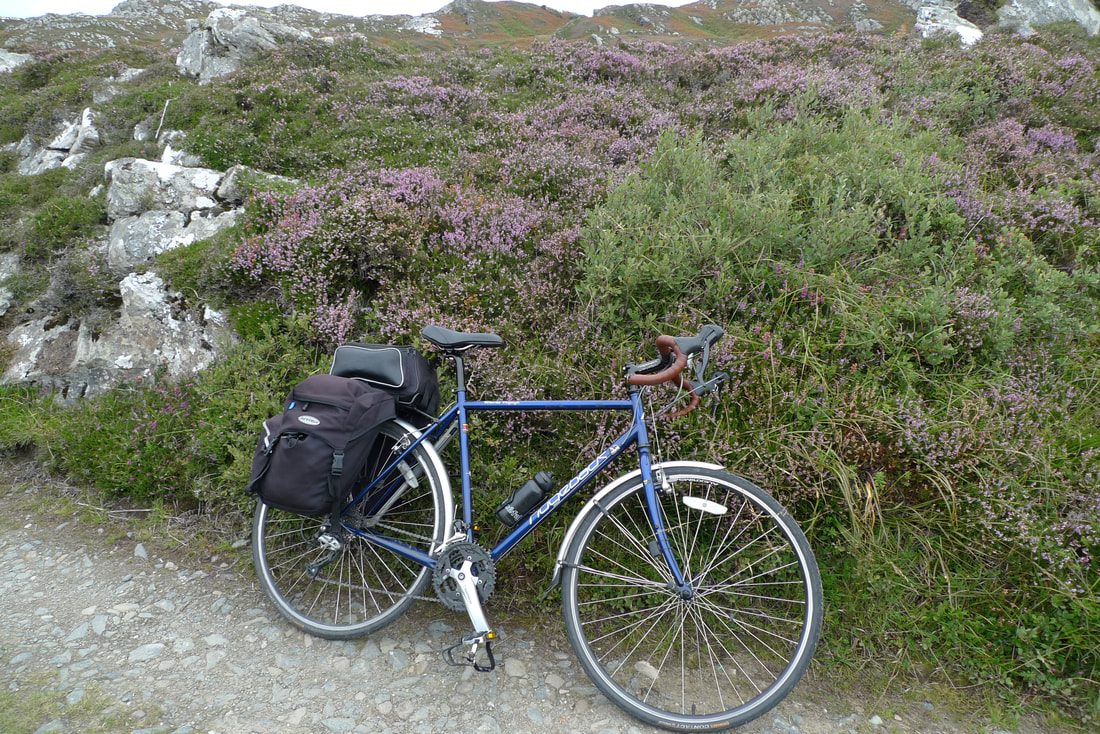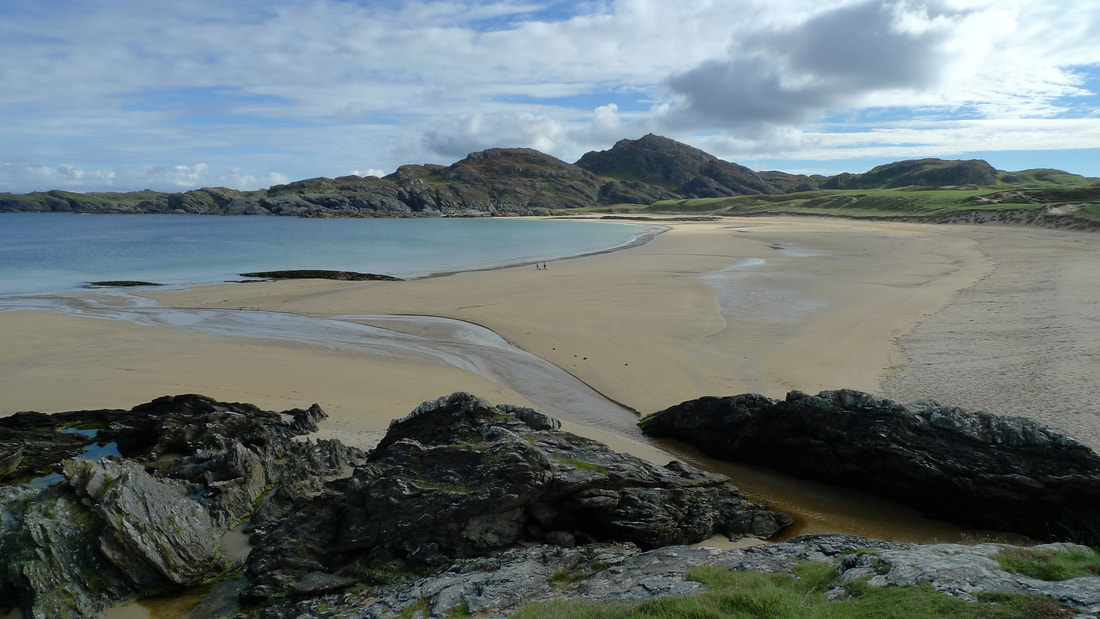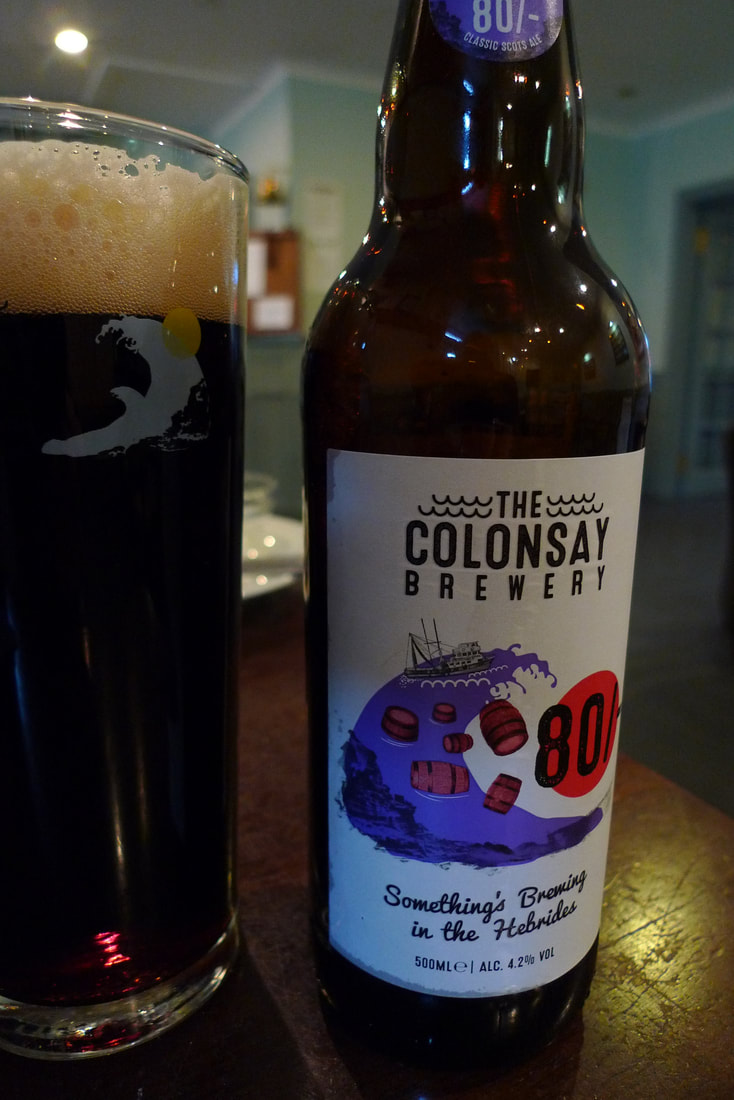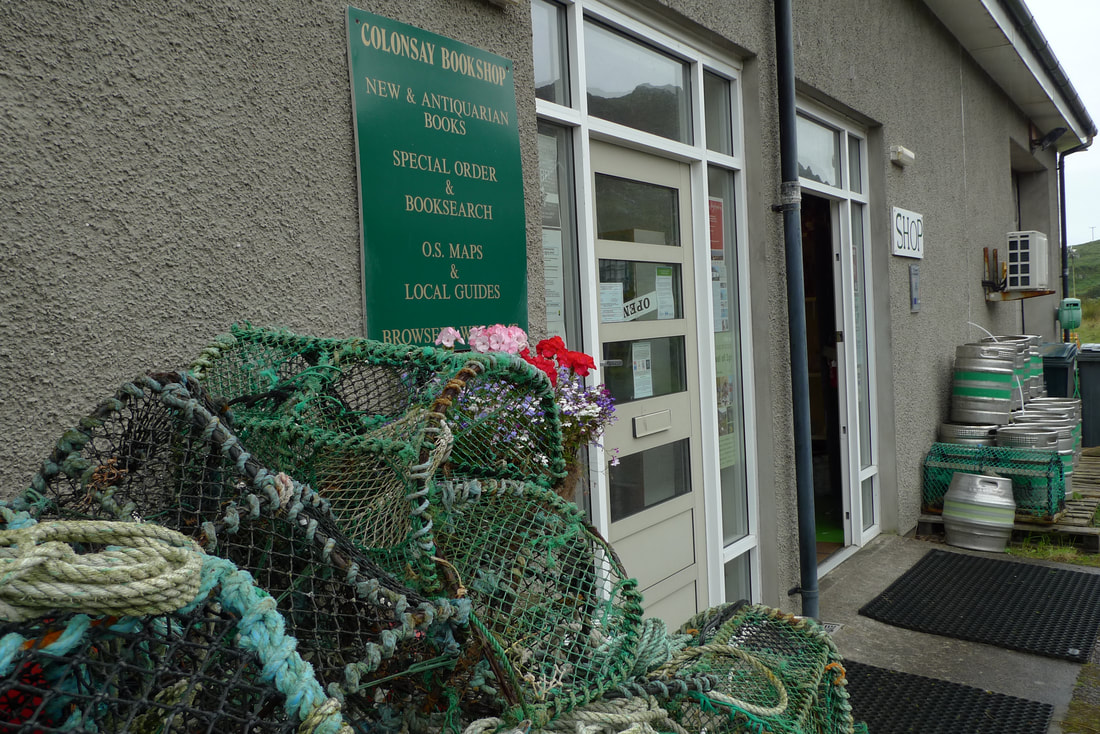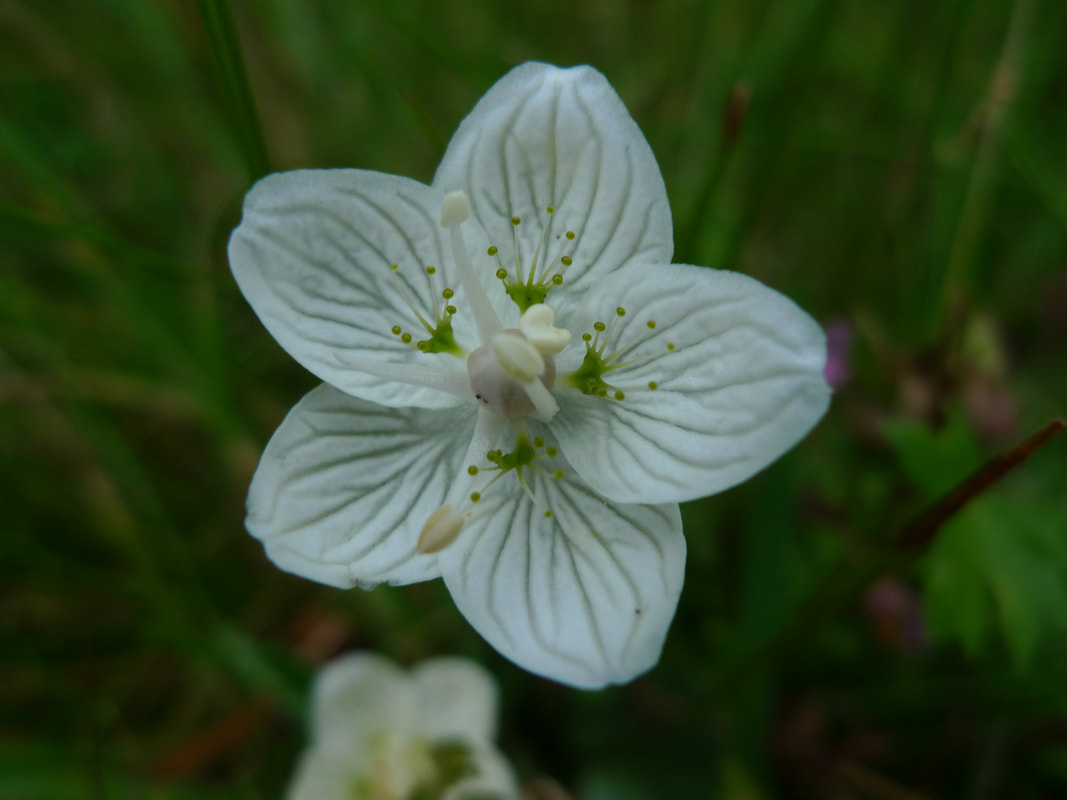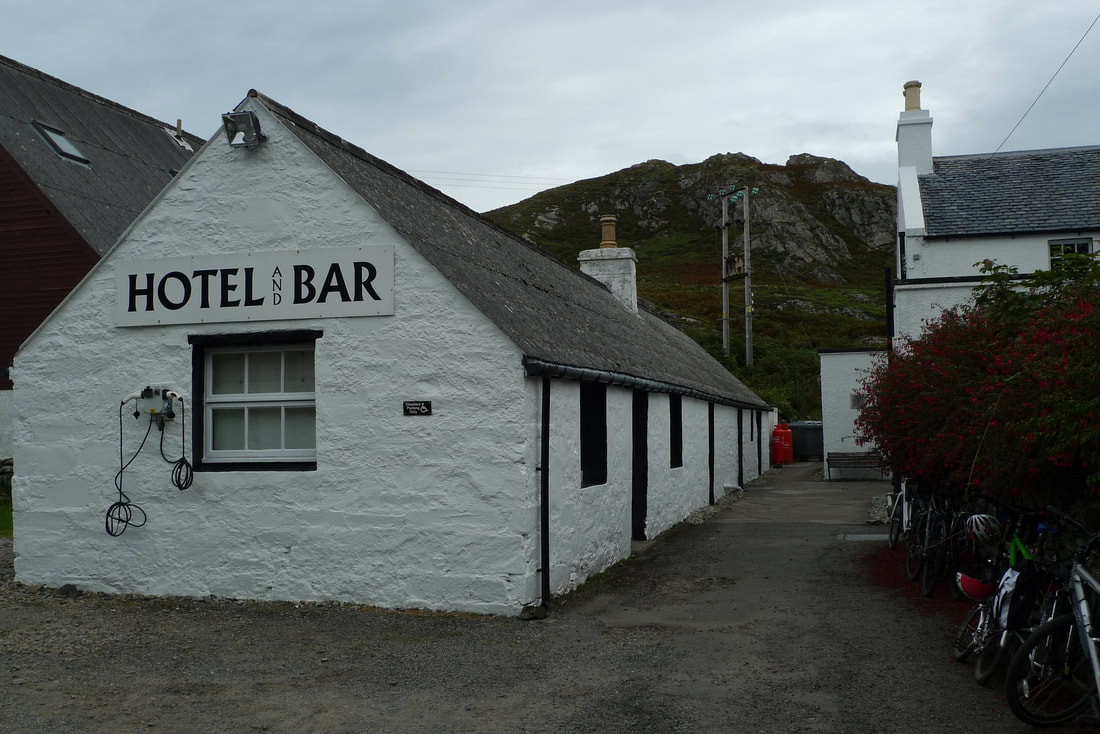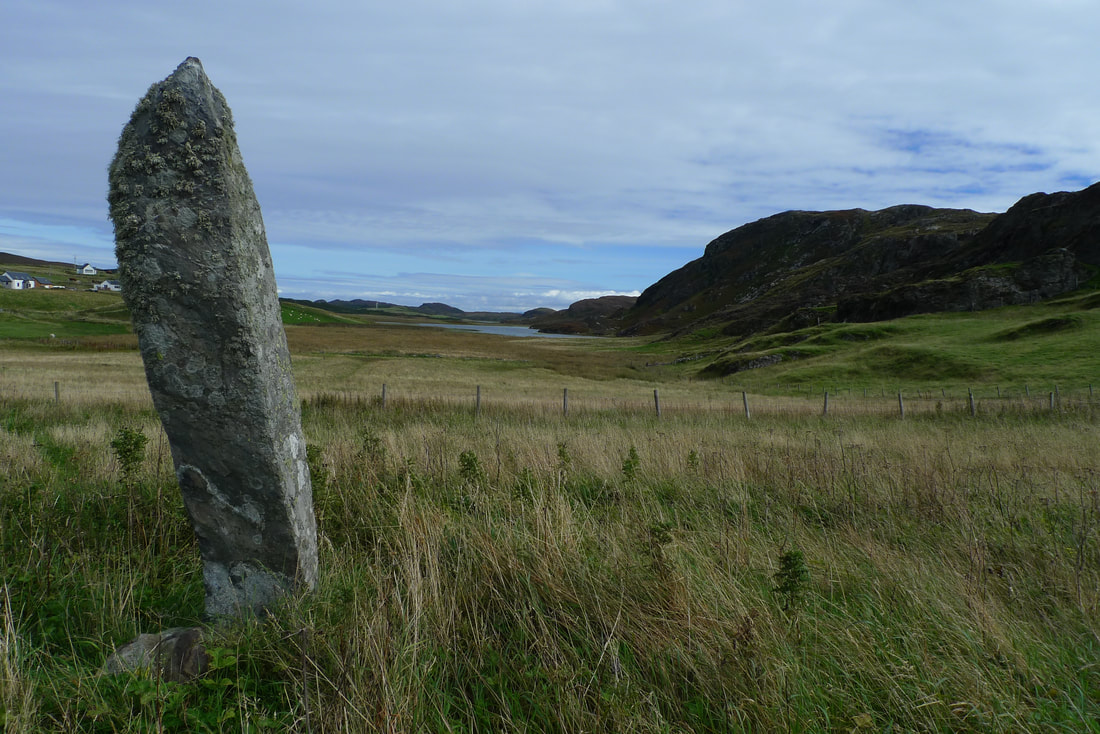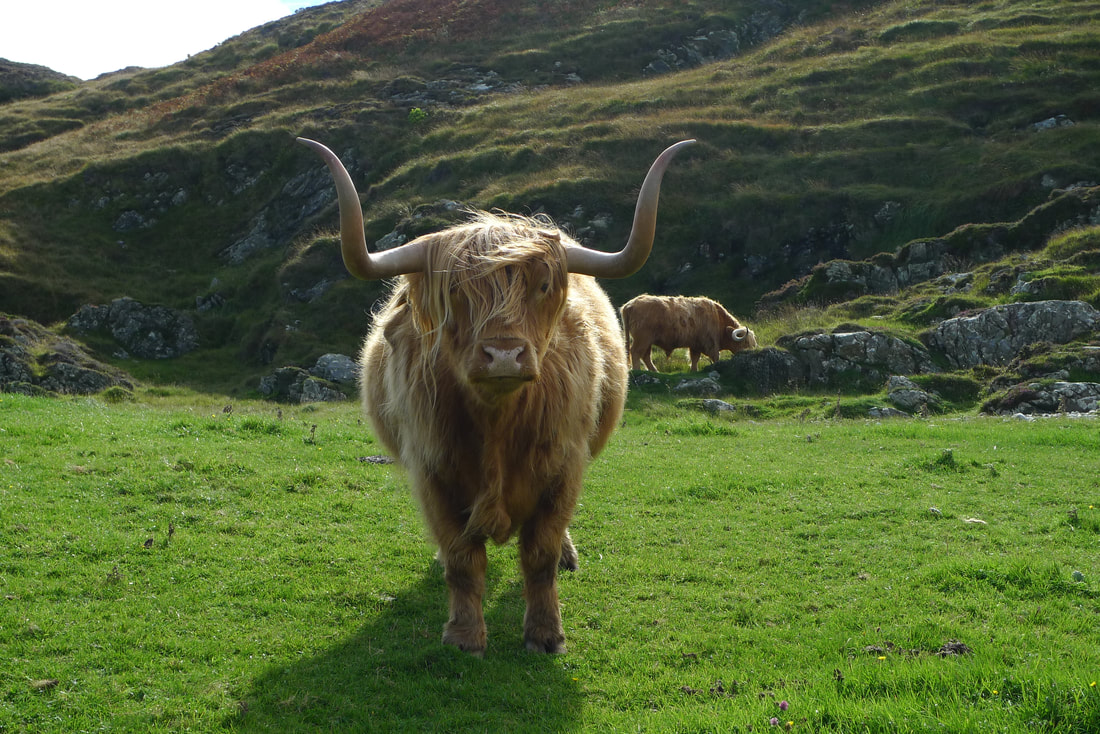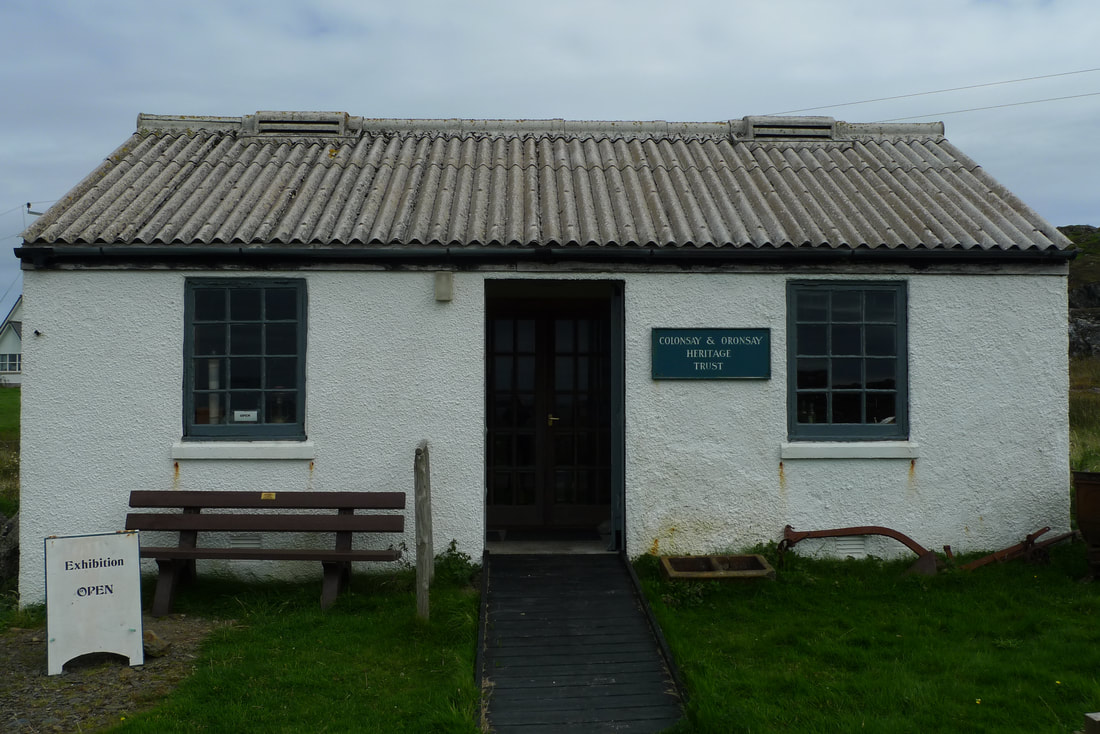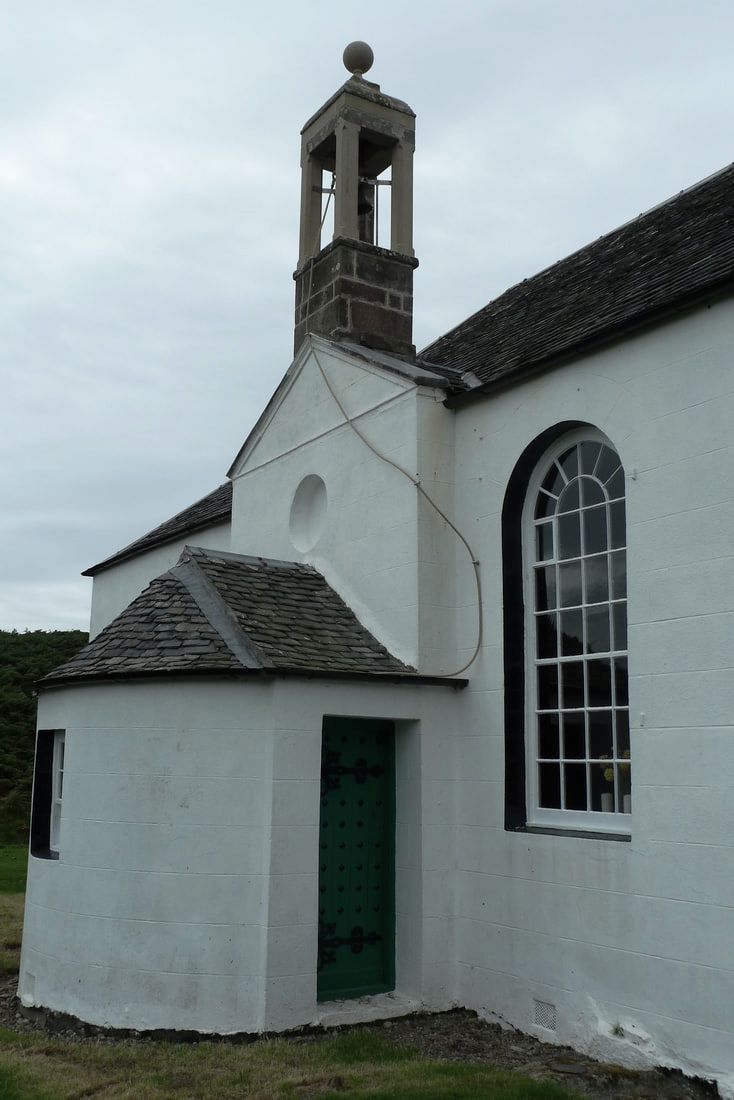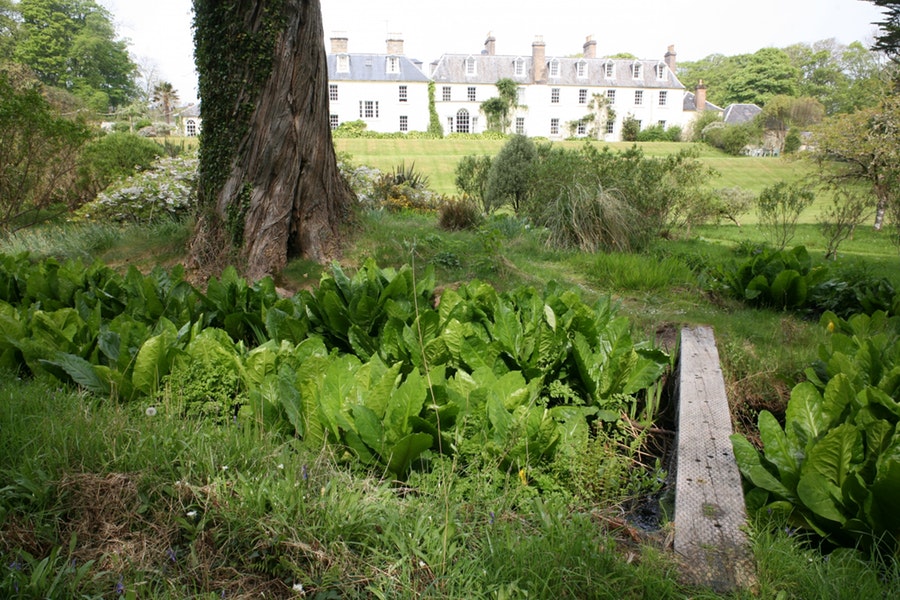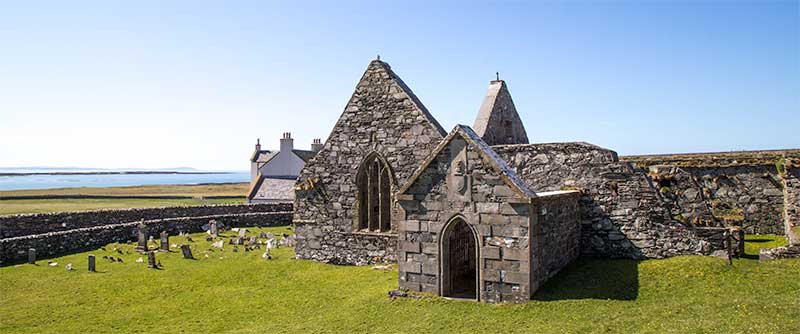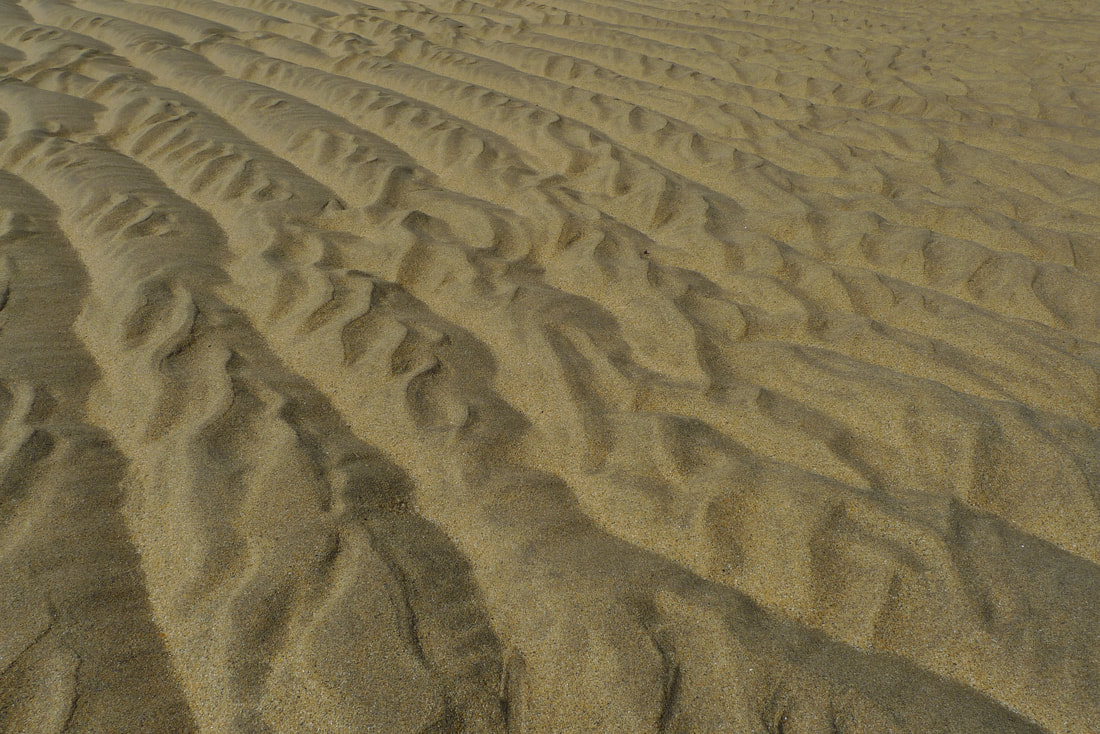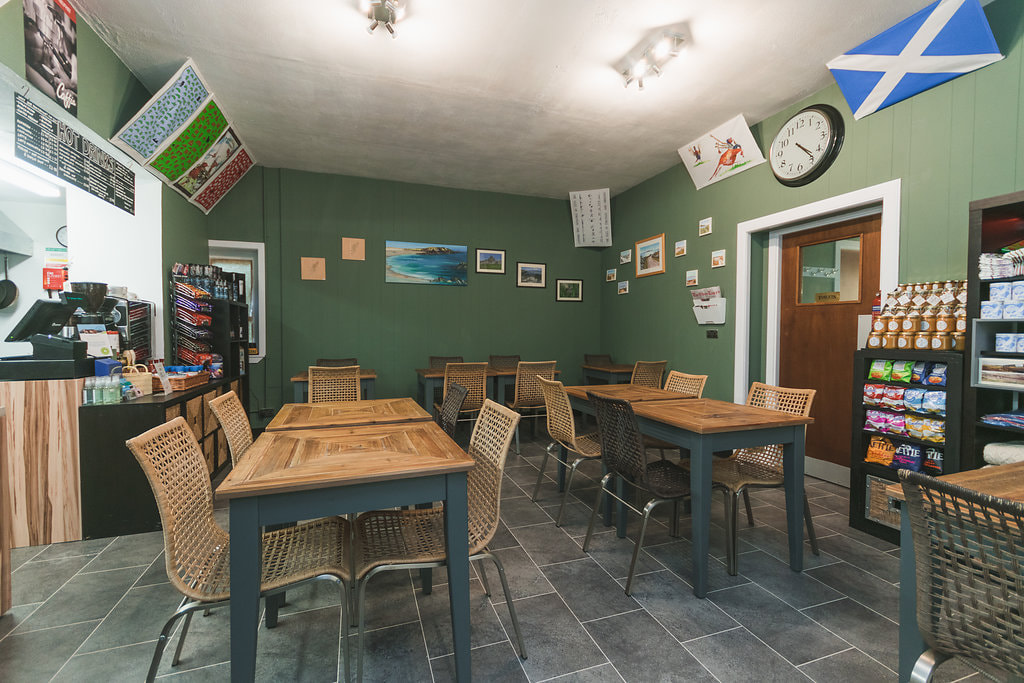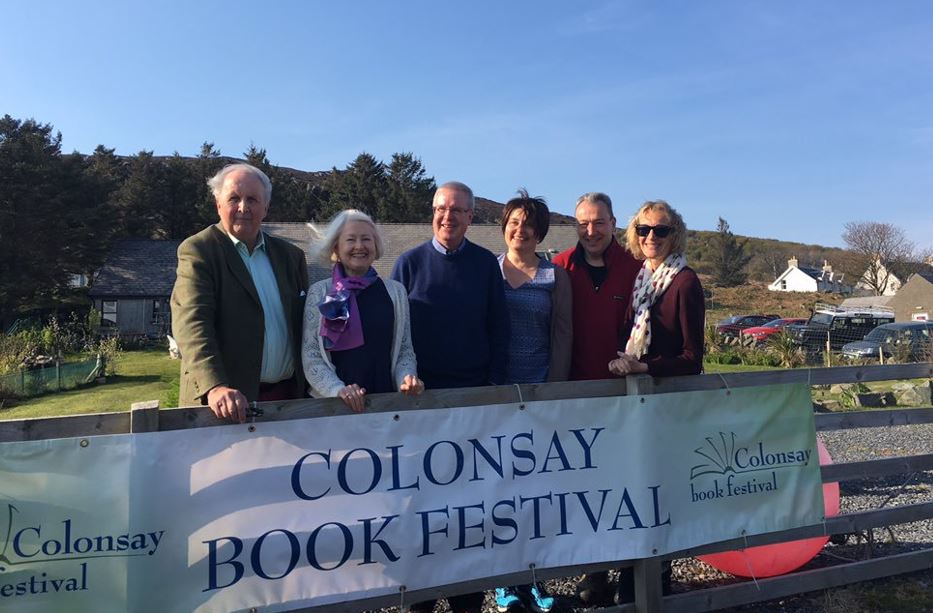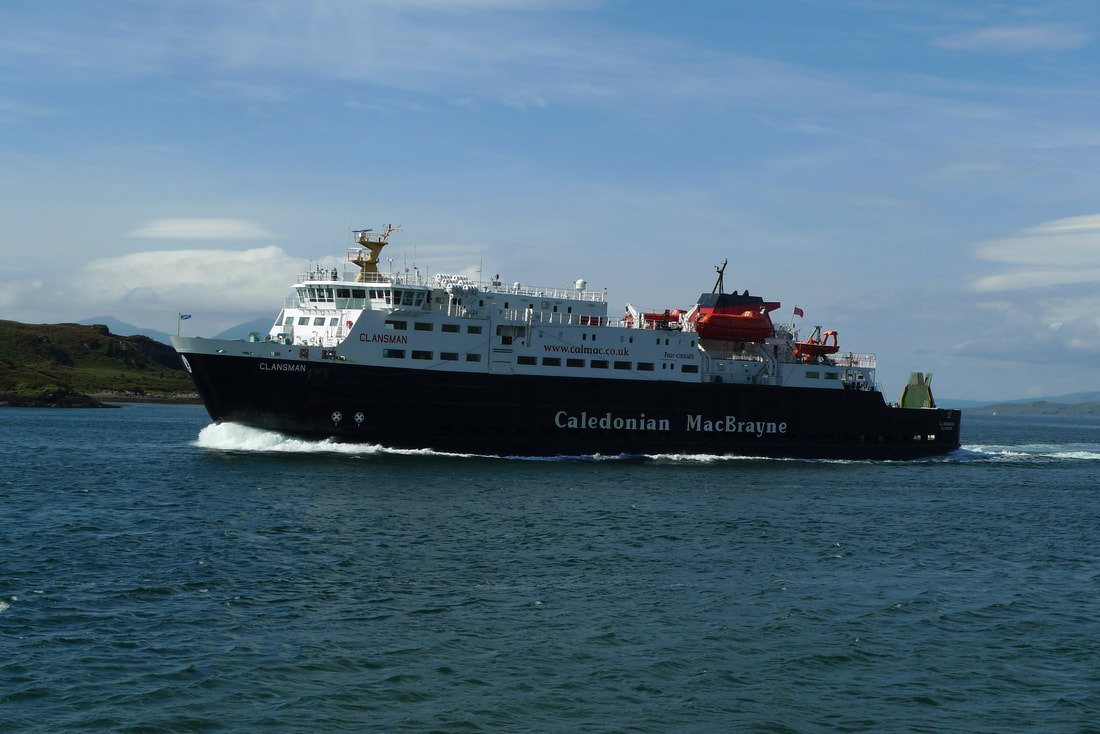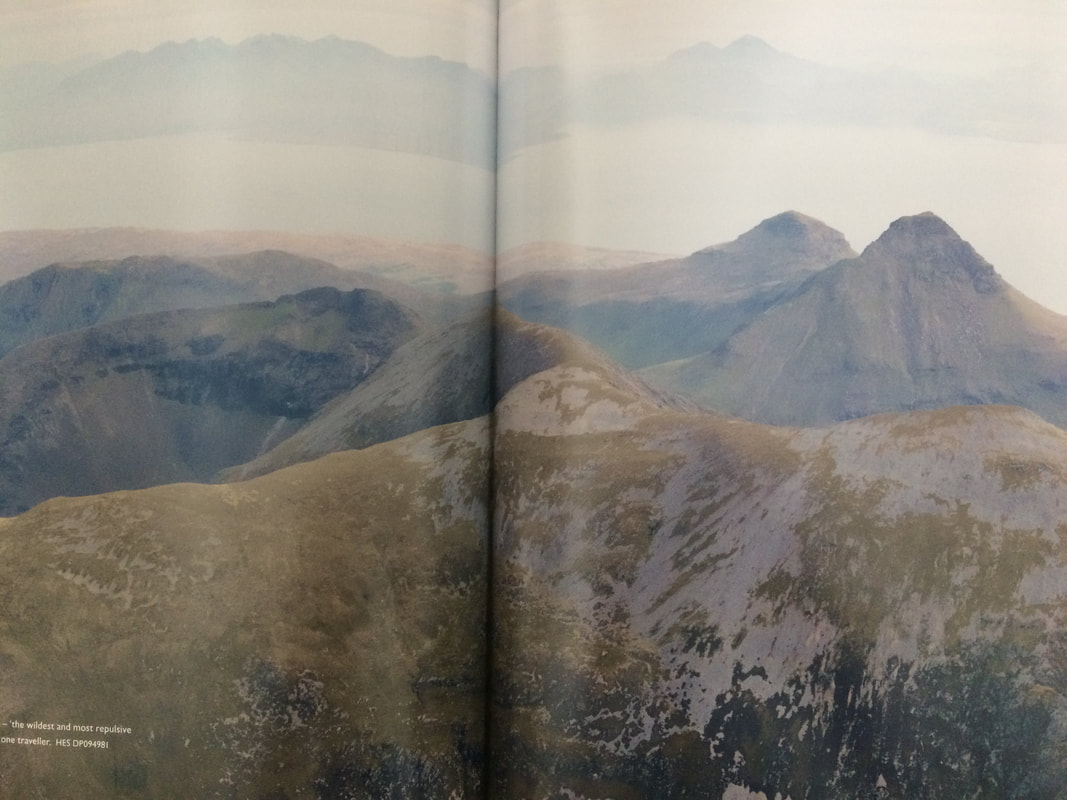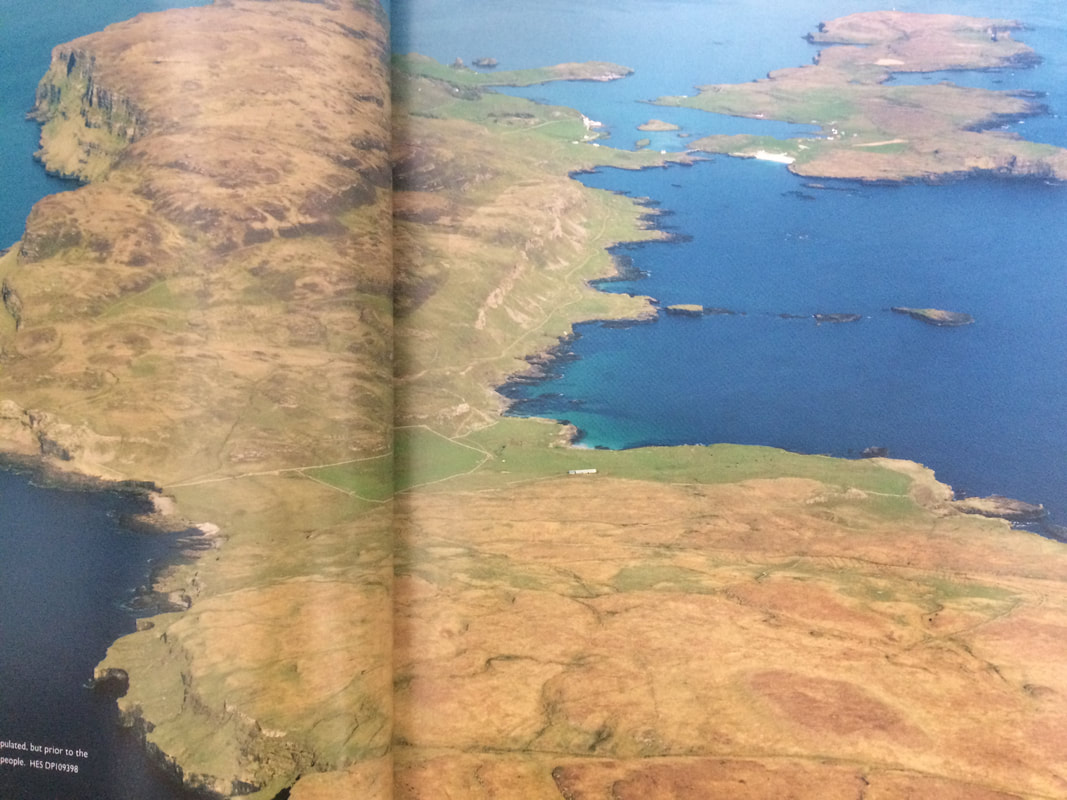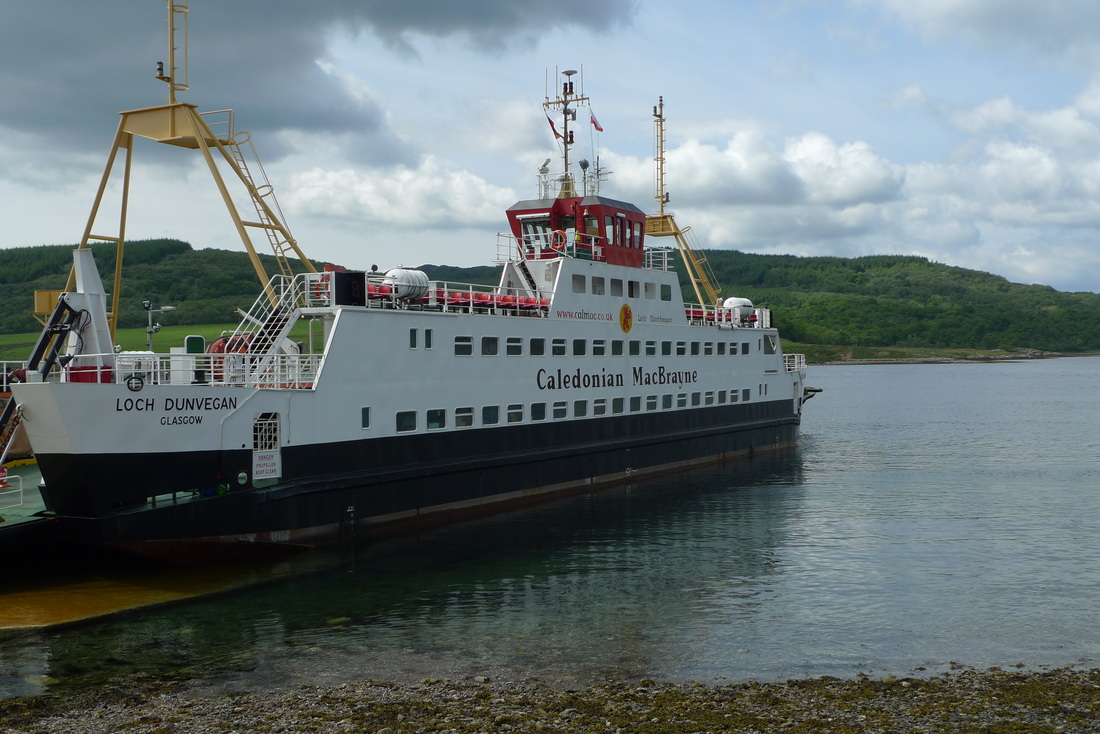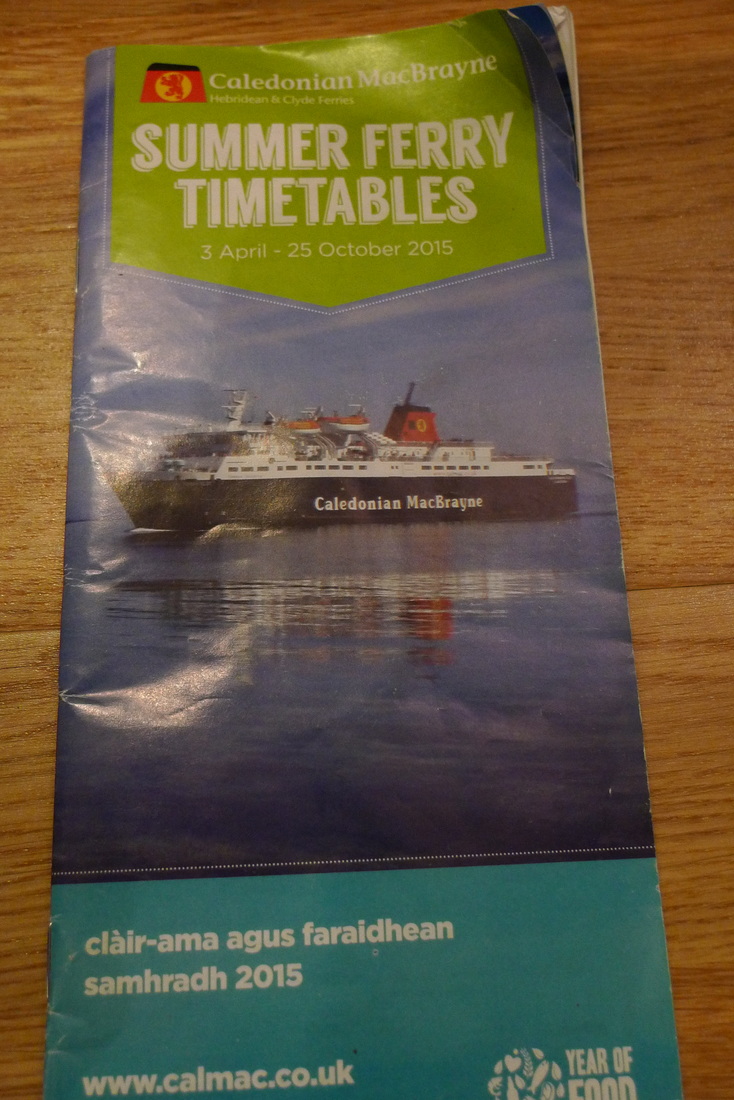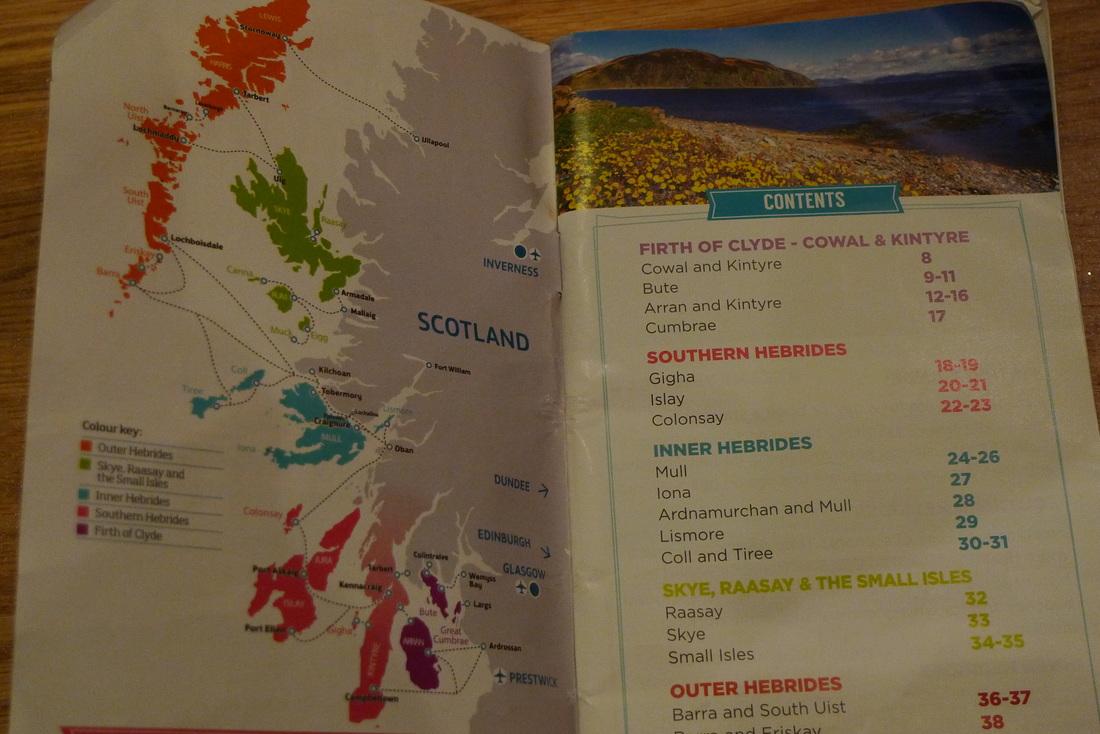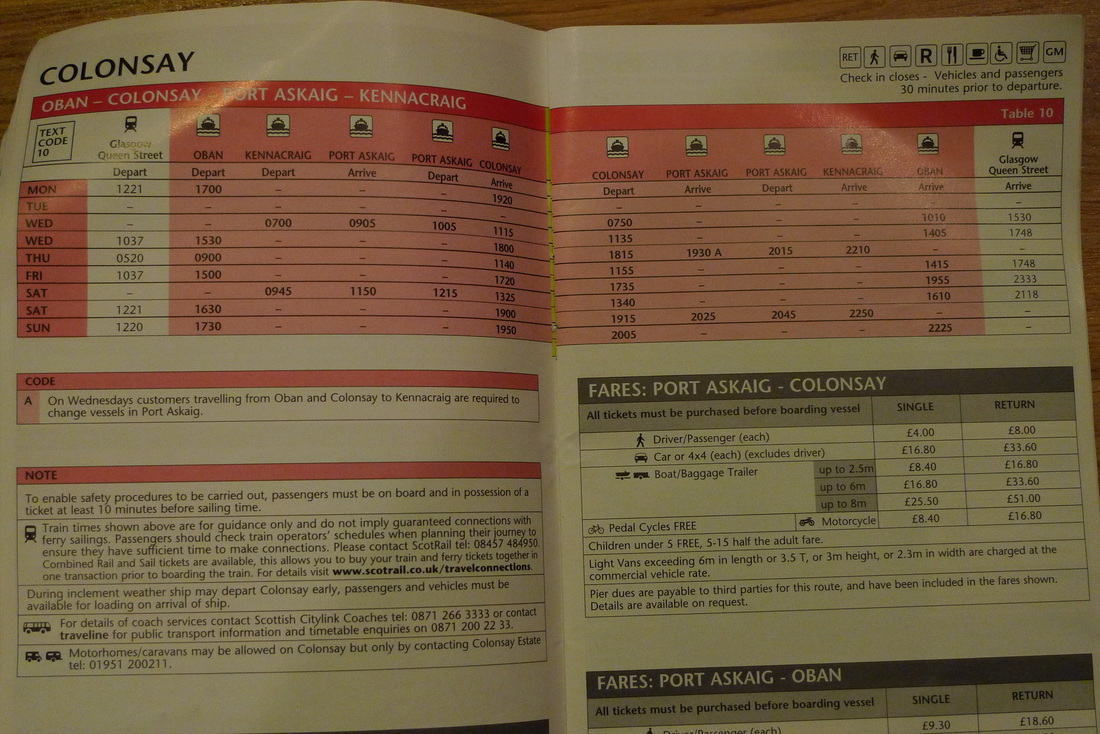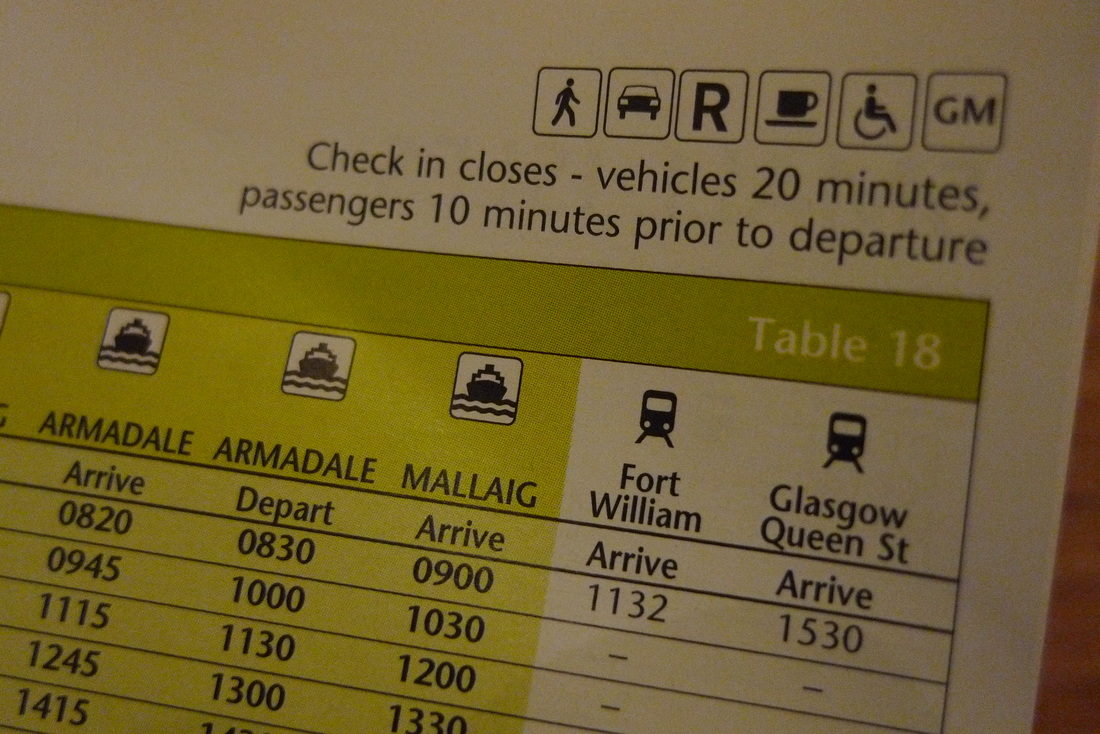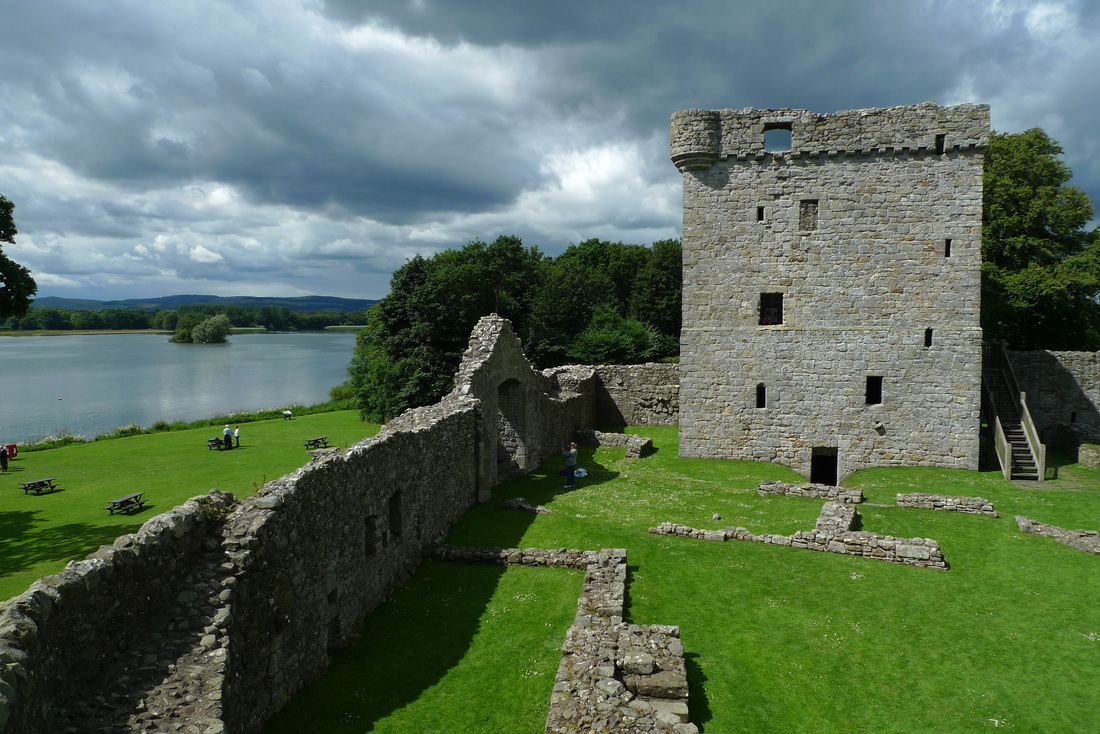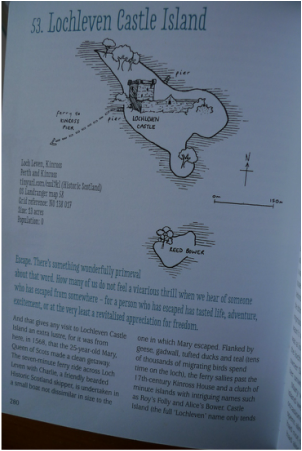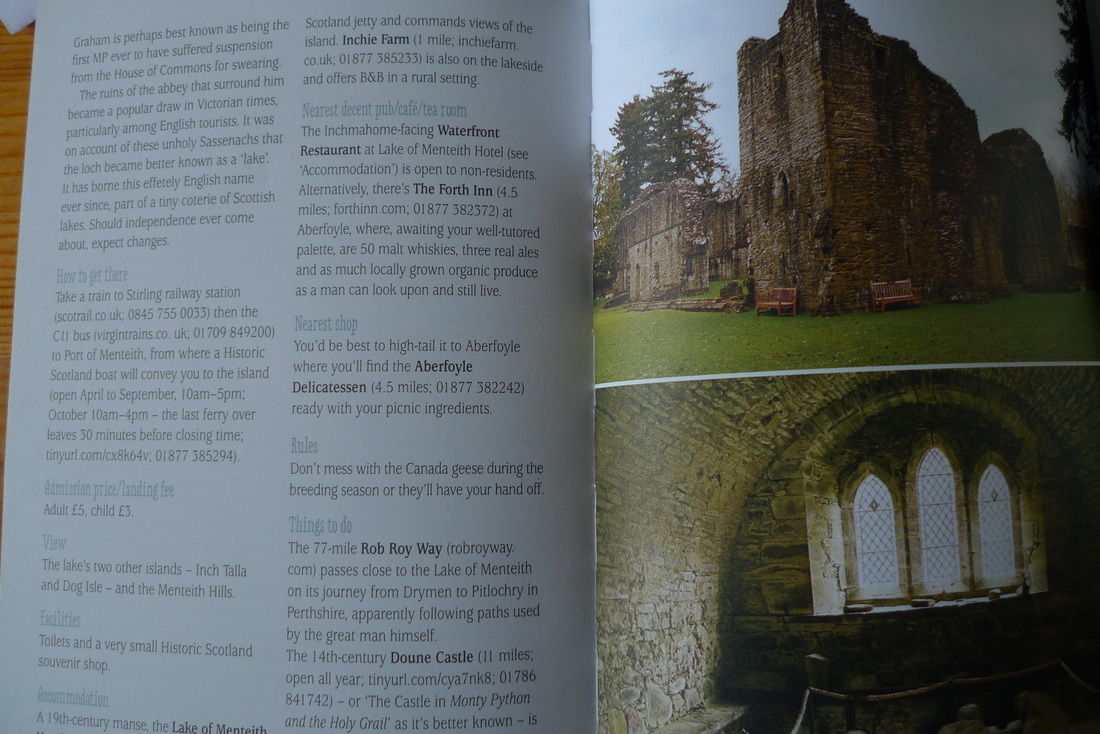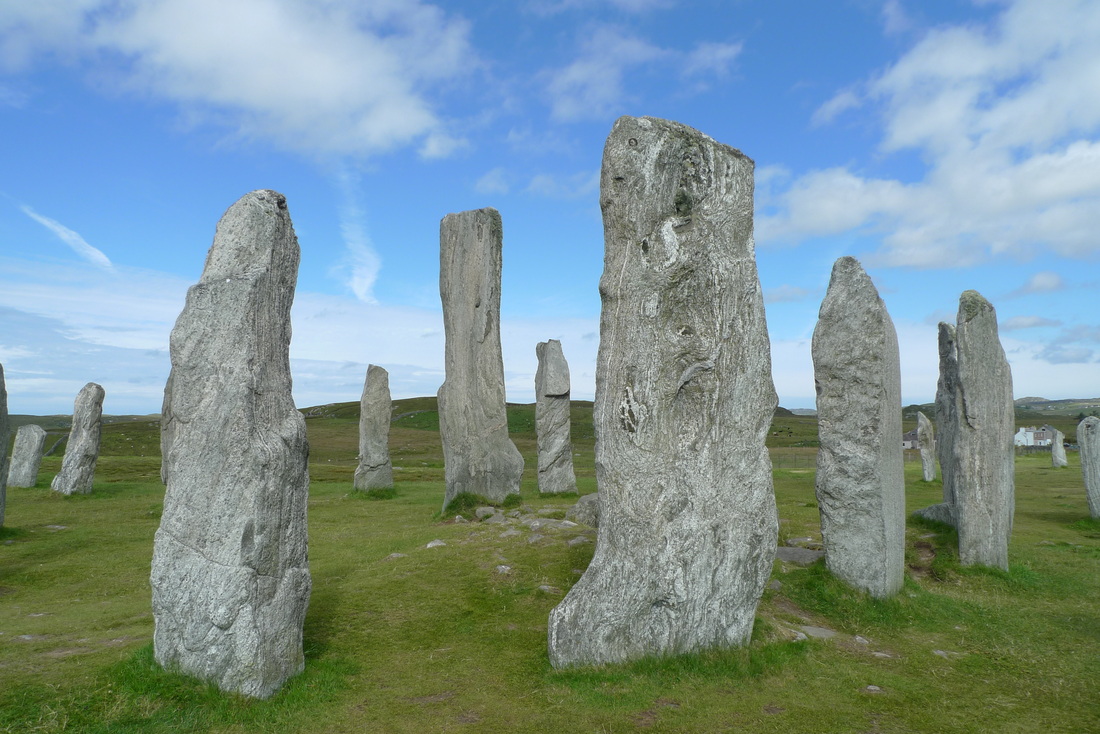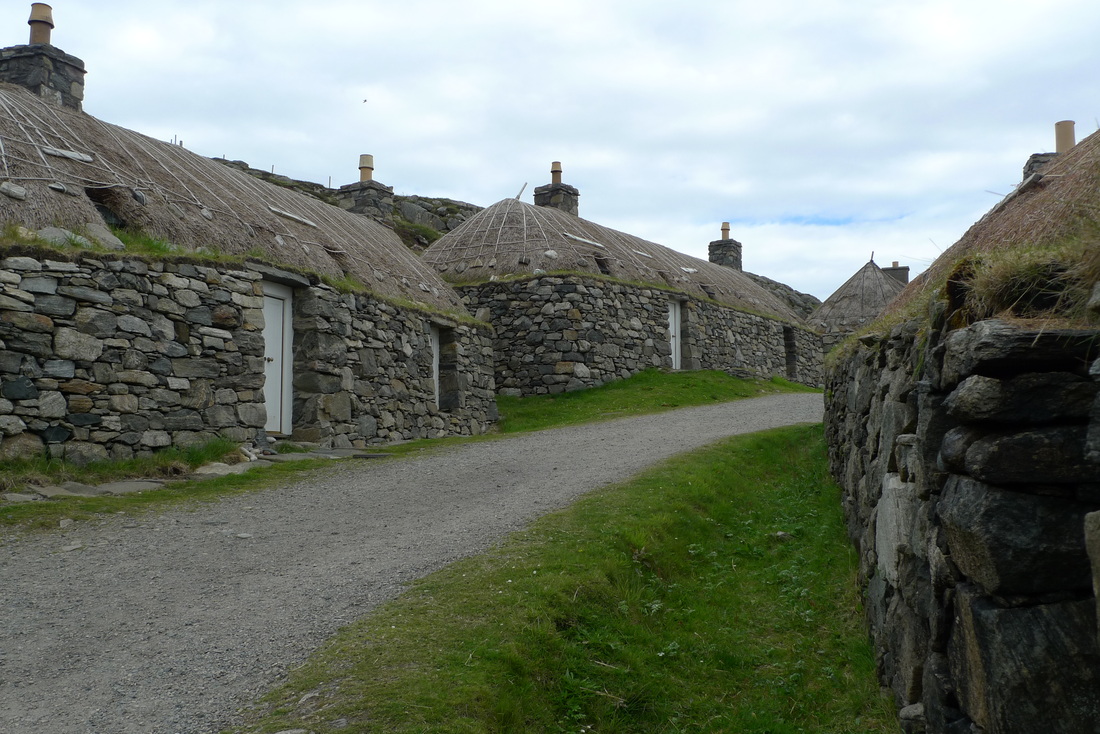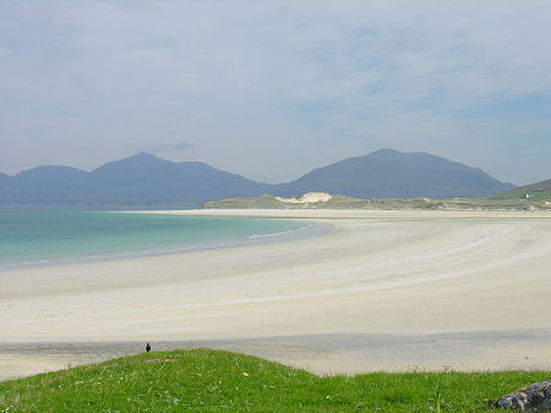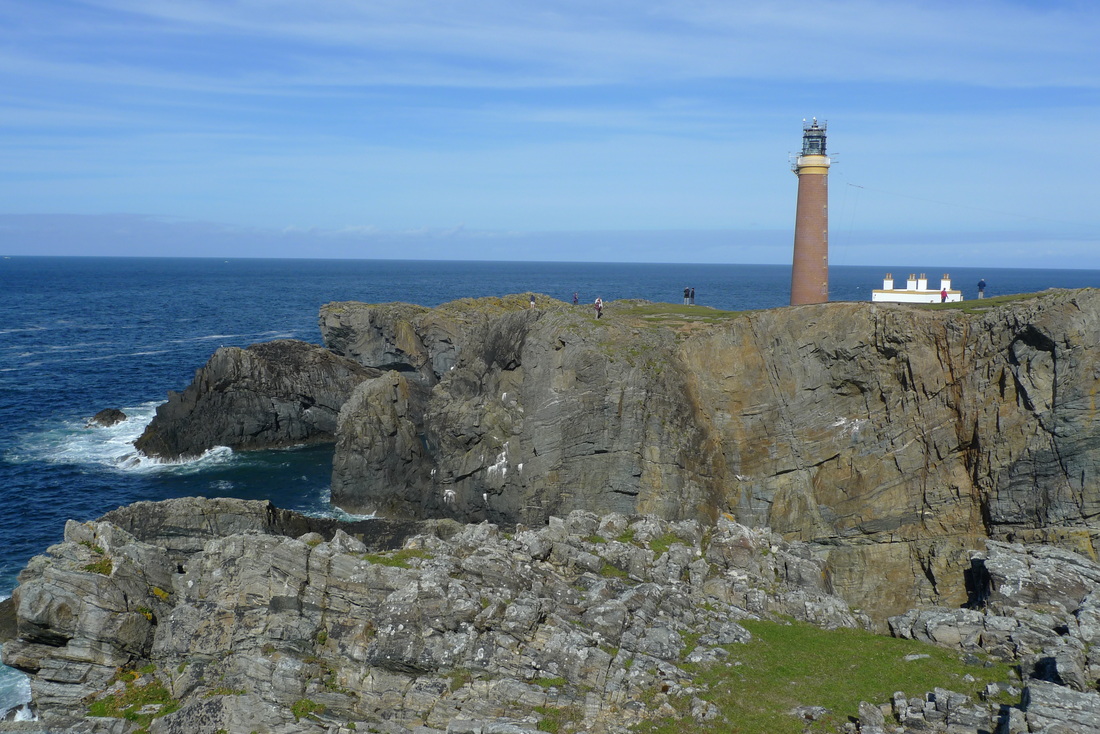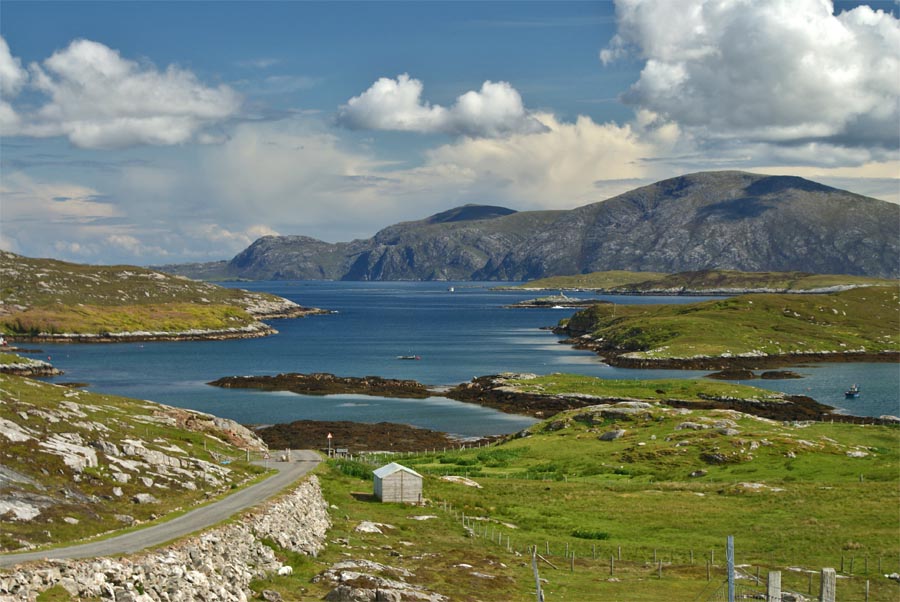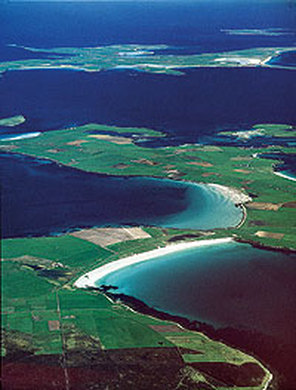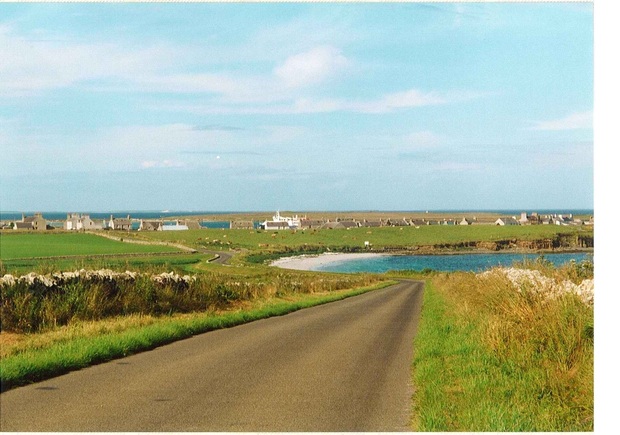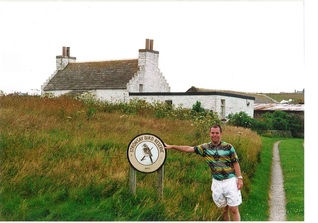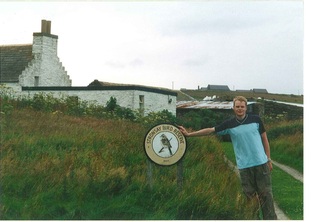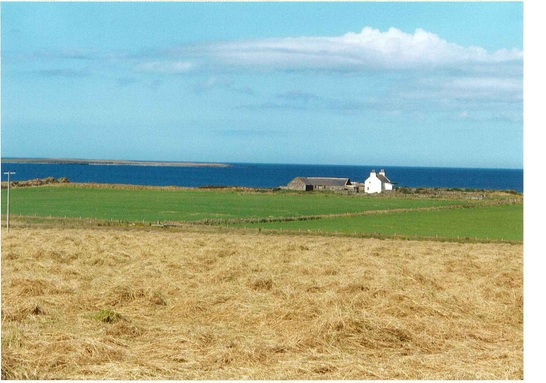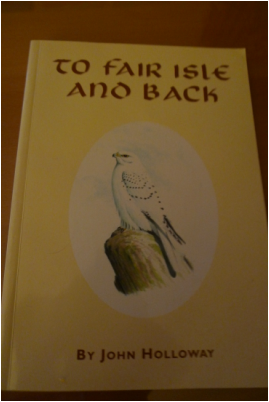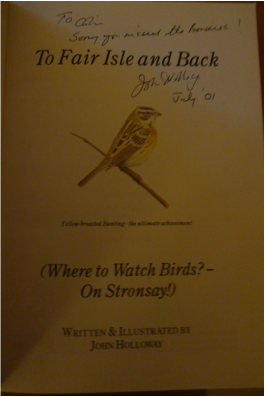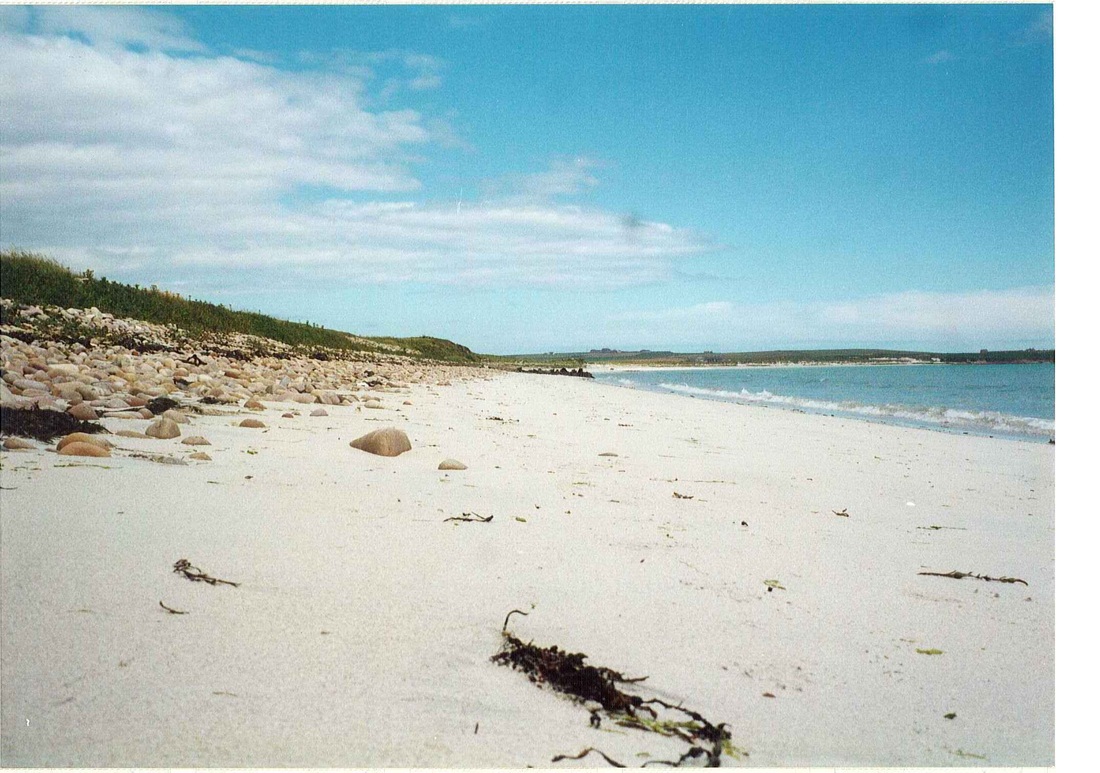|
They were known as the islands that roofed the world because of their huge slate deposits. The Slate Islands have a rich industrial heritage in beautiful surroundings. They are 12 miles south of Oban and a joy to explore by bike.
Highlights
Getting there
The first step is to travel the 12 miles from Oban to the Clachan Bridge, the 'bridge over the Atlantic.'
The Clachan Bridge takes you over to the Isle of Seil, the northernmost Slate Island. The single-track road on the island feels like it's a guest here, almost overwhelmed by the trees, ferns and grasses that enclose it.
Kilbrandon Church
Three miles from the Clachan Bridge you'll find this gorgeous church. The interior is worth seeing with the stunning stained glass windows beautifully framed by the bare stone walls.
From the church there's a view to Ballachuan Loch, surrounded by the lush greenery that carpets the island. Beyond the loch and across the sound are the hills on the mainland. They look imposing and rocky.
Ferry to Luing
Just under a mile from the church is Cuan where you can catch the ferry to the Isle of Luing.
The ferry runs every 30 minutes and the crossing takes about 5 minutes.
Even a short ferry trip has a restorative effect. There's something about the motion, the sound of water against the hull and the sea spray that makes you go into an almost meditative state.
How I felt coming here was perfectly summed up on one of the island's tourist information panels: "Isle of Luing- a place to think, a place to be."
Arriving in Luing the rain came on heavy. I sheltered in the ferry waiting room. It's kitted out with cushions, a stack of magazines and a noticeboard with community information.
Views and perfect roads
There's a steep climb to leave the ferry dock, but the views are spectacular at the top. Even with clouds and mist the composition of water, islands and hills would sell a million postcards.
I knew immediately that I wanted to spend longer here. Reader, you should come here and enjoy this road. There's hardly any traffic and the green colours and landscape textures will make you smile all the way.
At one point the road was blocked by a cow that was not for moving. She stood her ground as I carefully went around.
Cullipool
Around 2.5 miles from the ferry is Culipool. It's the largest settlement on the island, but that doesn't mean it's a busy place. Quite the opposite. The streets of white cottages were quiet and I didn't see another person.
It's very different to how this place must have been when the slate quarry was operating. It once employed 175 men and these cottages were their homes.
The quarry closed in 1965 and its remains are a fascinating, alien word. There are big hillsides in various states of destruction.
Men were once suspended by rope from the top of these hills. They drilled holes and packed them with gunpowder. The blasts left these hills looking like something from a sci-fi film set. The ground is littered with shattered slate of all different sizes and shapes.
The beach at Cullipool is covered in shards of slate. When the waves roll in they push and then pull the slate. The sound this makes is gentle, soothing. It's a memory that will stay with me long after I depart these islands.
I had to catch the last ferry back to the Isle of Seil so I couldn't spend any longer on Luing. If I am lucky to return one day I would visit:
The ferry was busier this time. The vehicle deck was so full that a van was on the ramp with its rear wheels dangling over the water. Ellenabeich, Isle of Seil
It's about 3.5 miles from the ferry to Ellenabeich, the largest village on the island of Seil.
It's another settlement with rows of white workers cottages. Some have small front gardens adorned with plants. There's a village square with a crane rescued from the derelict pier as a a focal point. There's also a shop and a classic red phone box that looks great set against the white washed buildings. The street lamps, have a vintage look, a bit like gas lamps.
The Oyster Bar is the only place for a meal. There's quality seafood, burgers, steak and more. I had chowder. This was a super tasty creamy potato broth packed with smoked salmon, smoked haddock, prawns and scallops.
A night out
A normal Tuesday night at home would probably be spent watching the TV. In Ellenabeich I went for a bike ride.
I took the hill out of the village. The view up here shows off the beauty of this place. The craggy hill, Dun Mor, dominates the scene. You can see how close Easdale Island is to Ellenabeich. This island is famous for hosting the World Stone Skimming Championships each year. Competitors use Easdale slate skimming stones in one of the disused quarries. The island is car-free as the ferry takes only passengers. I didn't have time to visit Easdale this time around.
I explored the rocky shoreline and the slate covered beaches. Apart from the gently rolling waves the only other sounds were the cry of seabirds and the occasional bleating sheep.
Garragh Mhor bed and breakfast
I stayed in Garragh Mhor on Ellenabeich. The hosts were super welcoming. They told me about the incredible wildlife on the island. Otters passed their front door a few days ago. There was a time when a guest forgot to close the door and lots of toads made their way inside! A swarm of hornets once gathered above the B&B- it was like a black cloud sitting just above the roof.
I love that conversations with B&B owners can give you a real flavour of what it's like to live in the places you visit. Oh, and the smoked salmon with scrambled eggs for breakfast was superb. My thoughts on the Slate Islands
The Slate Islands are not as well-known as other islands in Scotland, like Skye or Harris. That can make them quieter, but the experience is just as good as those other places.
I thought the scenery was spectacular. I loved the novelty of crossing the 'bridge over the Atlantic' to get to the islands and then the short ferry ride across to Luing. The quiet roads make for great cycling and the industrial heritage of the islands is a fascinating part of Scotland's history. Explore Argyll and Bute
The Slate Islands are in Argyll and Bute. You can read more blogs about this part of Scotland.
5 Comments
Colonsay is an island on Scotland's west coast, 30 miles from the mainland. It is famed for its beaches, wildlife and tranquility. It even has a brewery and a golf course! It is 10 miles long and 2 miles wide with just over 100 people living there. Read on to discover 15 things you can see and do on the Island of Colonsay. 1. CyclingAn obvious choice for my blog! However, cycling really is the best way to explore the island- it is only 10 miles long and there are very few cars to worry about on the single-track roads. It will also save you the cost of taking your car across on the ferry. It is free to take bikes on the ferry and if you don't have your own bike you can hire one on the island. 2. Kiloran BeachOne of Scotland's most beautiful beaches, Kiloran, is a must-see on the island. It is an expanse of golden sand with dunes and caves to explore. There is a good chance that you will come across the grazing cattle that often stroll onto the sand. 3. Sip a Beer from Colonsay BreweryColonsay is the smallest island in the world with its own brewery. With a fact like that you just have to try one (or a few) of their beers! I love the colourful bottle labels and the 80 shilling (pictured) is my favourite. It is a dark ale with a taste of peat, which gives it a particularly 'Scottish' taste that makes you think of the islands and strong whiskies. You can buy the beer from the brewery shop which is near the ferry terminal. It is also sold in the hotel and onboard the ferry. If gin is more your thing there is also a distillery on the island called Wild Thyme Spirits. 4. Go Book ShoppingNext door to the Colonsay Brewery is the bookshop. There is a great selection of works about island history and culture, and if you are just looking for something for a rainy day there is a wide choice of fiction and non-fiction. During my visit I heard a customer stating "chemistry is more my thing" in response to the bookseller letting them know of an upcoming sale of philosphy books. 5. Look for WildlifeSeals, Golden Eagles and Otters can be see on the Island of Colonsay. Perhaps a lot easier to spot are the beautiful wildflowers. Take a close look at the ground as you explore the island and you will find plenty of pretty delights. The abundance of flowers sustains the production of Colonsay Wildflower Honey which you can buy from the Pantry, a cafe near the ferry terminal. 6. Oysters at The Colonsay HotelSampling local sea food is a must when visiting a Scottish Island. Pop into The Colonsay Hotel, the only hotel on the island, to enjoy Colonsay salmon and oysters. It is a cosy place with open fires and wooden floorboards so settle in and enjoy a beer from the Colonsay Brewery. 7. Touch Ancient Standing StonesNear Lower Kilchattan look out for a gate with a painted notice, 'foot path to standing stones'. Walk through ankle height grass to reach a pair of stones that are the last remains of a stone circle. The stones are known as Fingal's Limpet Hammers' as they have the appearance of the tool that was used to detach limpets from rocks. Feel their surface, crusty with moss, and imagine the others who have put their hands here through the centuries. 8. Search for Highland CattleTake the very steep road that travels west of Kiloran beach. It takes a bit of effort on a bicycle! When the road eventually ends there is a gate with a sign stating that this is the footpath to a beach. Highland Cattle can sometimes be found grazing on this beach, so it is a great spot to get a closer look at these engimatic creatures. This is a pebble beach and it takes a bit of effort to reach it so you will probably get it (and the coos!) all to yourself. 9. Colonsay Heritage TrustHoused in a former Baptist Church this museum tells the history of the island through objects, photographs and information panels. 10. Go To ChurchColonsay parish church, built in 1802, is gleaming white with fine Georgian architectural features, particularly the large round windows that let light flood in. The church is always open so come inside to have a look and enjoy some quiet contemplation. Incredibly it was originally designed to seat 400, somewhat optimistic for this tiny island. During my visit the pews were laid with second hand books that you could buy by popping a £1 coin into an honesty box. 11. Colonsay House and GardensThese gardens are famous for their rhododendrons and the mild climate means that subtropical plants also thrive here- there are acacia and eucaplyptus. There is a cafe that serves afternoon tea, lunches and snacks. The gardens were not open during my visit, so if you want to see them make sure you plan to come on a Wednesday, Friday or Saturday during the summer months. Check the Colonsay Holidays website for current opening hours. 12. Take in Another Island- Walk Over to OronsayAt low tide you can walk over to the island of Oronsay. Tide times can be checked with the Post Office on Colonsay. There is a 14th century Augustine priory to explore and you might spot the Grey Seal colonoy on a coastal walk. 14. Read a Book, Relax, Do NothingOne of the main joys of spending time on of Scotland's islands is that it offers a complete escape from the stresses of modern life. You should take advantage of this and find a quiet spot to sit and do nothing or perhaps read the book you purchased from Colonsay Bookshop. Even watching the ferry arrive and depart is a good way to slow down and relax- watching the vessel glide across a calm water can be pretty mesmerising. 15. Cake at The PantryThe cake cabinet in The Colonsay Pantry is where you will find the island's best homebaking. This friendly cafe is just a couple of hundred yards from the ferry pier and offers outdoor and indoor seating. During my visit I had hearty lentil and tomato soup followed by a luscious slice of caramel shortcake and superb barista-made coffee. The Pantry also provides evening meals on selected nights- check their website for the current offerning. 15. Go to an EventFor a small island it is surprising just how many events take place on Colonsay. There is a book festival, a music festival and a food and drink festival. For sporting enthusiasts there is the Colonsay International Golf Open and regular football matches. There are also regular ceilidhs if dancing is more your thing. How to Get to ColonsayThe Caledonian MacBrayne ferry takes around 2 hours and 20 minutes to travel from Oban to Colonsay. The ferry service is more frequent in summer. Most of the departures from Oban are late afternoon and the departures from Colonsay are in the evening. This means an overnight stay is necessary on the island, but that is a good thing as this is a beautiful place. However, if you can really only afford a day there is also ferry service from the Island of Islay that gives you about 6 hours on Colonsay. Check the ferry website for current timetables.
Got Some Time to Spare in Oban? If you are waiting for your ferry to Colonsay and looking for something to do why not visit Dunstaffnage Castle or treat yourself at Oban Chocolate Company? Explore more of Argyll and Bute Colonsay is located in the Argyll and Bute region of Scotland. Head to my Argyll and Bute page for ideas of more places to visit.
The history, heritage and archaeology of Scotland's 'small isles'- Rum, Eigg, Canna and Muck- is beautifully presented in this coffee table book. It is packed full of spectacular photography, particularly the aerial views of the islands, that provide the reader with hours of fascination. This is accompanied by a very detailed text that explains everything about the historic landscape of the islands. This book will certainly inspire you to visit these beautiful places.
Each island has its own chapter. This opens with a map of the island that pinpoints the locations of the points of interest that are covered in the chapter. This means that you could use this book to plan visits to the islands and seek out particular buildings or archaeological sites.
The text is very detailed and has clearly taken a lot of time to put together. In that sense it is not a traditional travel guide, but aimed at telling every aspect of the island's past through its human structures. I did not read every single page and tended to browse to the parts that interested me the most. It is the photography that makes this book such a pleasure to flick through. I loved the aerial photos that show how beautiful, lush and green the islands are.
This is a gorgeous book to have on your coffee table and inspire visits to these special islands.
You can buy a copy from Amazon by clicking on the image below: Scotland's islands are fantastic places to take your bicycle. They are the ultimate escape where the pace of life is always more relaxed, the roads are quiet and the scenery breathtaking. Travelling to them is always exciting because of the sea voyage. The Caledonian MacBrayne ferry timetable is something I love to pour over and plan island adventures.
The contents page lists the islands, their magical names (Gigha, Tiree, Skye...), enticing you to turn the pages and find out how to visit them. The timetable for each island provides you with lots of information, such as ticket prices and connections with trains. Every fare table has a bicycle symbol with the words "pedal cycles FREE" next to it, so you only ever pay the price of a passenger to take your bike on a ferry. As you make your way through the pages you can tell how remote an island is by the infrequency of the services. These islands excite me the most as they require a lot more planning to work out how to get there and how to get back. Each timetable has a collection of symbols that indicate what facilities are available on the ferry. On the longer ferry journeys the most important symbol to look for is the knife and fork because this means that there is a "Mariner's Restaurant" on the boat where you will be able to buy a hot meal. Calmac favourites include fish and chips, curry of the day and macaroni cheese. This is tasty and filling fuel if you have been on the bike all day. Calmac are proud that they source the best of Scottish food, so there is fish caught from the shores of the island of Barra, venison from Argyll, and Rannoch Moor smoked chicken.
So, there is plenty to look forward to when planning a trip to Scotland's islands. The Calmac ferry timetable provides plenty of inspiration and is always worth having in your bag. A true icon of travel. This book is a delight, a perfect combination of inspiration and information. It is a guide to 60 islands in Britain that are 300 acres or less in size. Twenty-five of the islands are in Scotland and many of these can be visited by bicycle, so this book provides plenty of ideas for island/cycle trips. Witty and sharp writing tells the story of the islands, whilst the stunning photography and hand-drawn maps illustrate what these places are like. It is a brilliant idea for a travel guide and the author must have had a great time researching these islands. He tells of encounters with locals and those who work on some of the islands. He uncovers fascinating histories and surprising facts. He describes the mini-adventures that are involved in travelling to some of the islands, largely involving tides or boats.
This is a book to dip in and out of and should be close at hand whenever you feel like your imagination could do with a bit of adventure. You just have to flick through a few pages and it won't be long before you find yourself planning your next island expedition. Scotland has again been recognised for its outstanding scenery with an award for Lewis and Harris from TripAdvisor. They were voted number one of the ten best islands in Europe. Two other Scottish islands made it to the list- Orkney and Isle of Mull. Top 10 islands in Europe 1 Lewis and Harris, Scotland, UK 2 Naxos, Greece 3 Island of Gozo, Malta 4 Mainland, Orkney, Scotland, UK 5 Milos, Greece 6 Cephalonia, Greece 7 Santorini, Greece 8 Island of Capri, Italy 9 Isle of Mull, Scotland, UK 10 Paros, Greece Lewis and Harris was also ranked the fifth best in the world. Here is the list: Top 10 islands in the world 1 Ambergris Caye, Belize 2 Providenciales, Turks and Caicos 3 Bora Bora, French Polynesia 4 Marco Island, Florida, US 5 Lewis and Harris, Scotland, UK 6 Naxos, Greece 7 Aitutaki, Cook Islands 8 Nosy Be, Madagascar 9 Easter Island, Chile 10 Ko Tao, Thailand Scotland also featured prominently in the UK’s best island list:
Top 10 islands in the UK 1 Lewis and Harris, Scotland 2 Mainland, Orkney, Scotland 3 Isle of Mull, Scotland 4 Jersey 5 Isle of Skye 6 Isle of Arran, Scotland 7 Isle of Man 8 Islay, Scotland 9 St Mary's, Isle of Scilly, England 10 Anglesey, Wales It is wonderful to see Scottish islands feature on these lists. I have cycled on all of the islands that have made these top ten lists and can attest to their beauty and fine range of things to see and do. I have written about my journey to Lewis to see the Callanish standing stones, pictured in the first image on this page. Although it was the stones that I was excited about seeing I ended up falling for the far north of the island at the Butt of Lewis with its lighthouse and crashing waves. Why were all the other cyclists going the opposite way to us? They were going south to north. We were going north to south. Paul and I were the only ones travelling the Western Isles in this direction. It didn’t take us long to find out why- we were riding into the wind and suffering. We actually had to peddle to go down hills! But the other cyclists were having a ball with the wind pushing them along at great speeds. How on earth did we manage to get this wrong and everybody else got it right? It was just the way things were for us. Our cycling trips always seemed to have something go wrong. It was the mishaps that made our trips so memorable and fun. This was only our second ever cycling trip and our planning left a lot to be desired- we missed the bit that said it is better to cycle south to north. As soon as we arrived on the Isle of Harris things went from bad to worse. The rain was heavy and our clothes quickly soaked through. In those days we still wore jeans on cycling trips- bad idea! We reached our bed and breakfast, dreaming of a shower and warmth. The owner opened the door and looked serious. Something was wrong. “I am very sorry. I have double booked you. I am so sorry. But don’t worry I have got you a room at my sister’s place. She lives just around the corner.” It turned out that “just around the corner” was another five miles away! We were sodden and cursed non-cyclists who freely used the term “just around the corner” when they knew fine well that they were thinking of cars when they said it. It was getting dark and we were getting wetter and colder. It was difficult to find anything enjoyable about this. At the time we did not know that we had to cycle another five miles, so after 15 minutes we began to wonder if we had gone too far. We spotted a man outside a cottage just standing there, seemingly unperturbed by the rain. Paul asked him directions and the man stood there staring straight ahead, smoking. He suddenly snapped out of his trance and started speaking. It was all mumbles and gibbering, so Paul gave up. We moved off, looking back to see that the man was still standing there, sheets of rain all around him. My head was down and I was focused on getting there, but the odd time that I did glance up I noticed that our surroundings were breathtaking, even in this foul weather. “It’s really beautiful around here,” I said to Paul. It was rocky, hilly and green, somewhat lunar. It was dotted with tiny lochs. It got me excited about being here and it made the rain not matter. We finally arrived at our bed and breakfast. Paul was fuming and determined to make this known to the sister. A frail old lady emerged onto the driveway to welcome us, “Oh deary me, you are all wet. Come inside boys.” She was very slow moving and had a very, very quiet voice. Paul could not bring himself to unleash his anger. It would be like shouting at your granny. She had made us sandwiches, scones and tea. It was just what we needed and within minutes there was not a single crumb left on the plates. It was Paul’s birthday and this should have been a special day for him. There would be no night out because there was nowhere to go for a night out. However, I had a bottle of champagne! I had hidden it inside my panniers and cycled with it for the past two days as we travelled across the Isle of Skye on our way here. Each time we went up a hill I felt the weight of that champagne, but now it was worth it as we toasted Paul’s birthday and our adventure. We settled down to watch a film- Groundhog Day- as we drank and relaxed. Two minutes before the end of the film all the lights and television went out. We burst out laughing- it was typical of the mishaps of our cycling trips. We suspected that it was not a real power cut, but that the sweet old lady wanted to go to sleep and she found our television a bit too loud so she simply pulled the fuse out!
Dream cycling country- this is what the island of Stronsay is. Flat, lush farmland and uninterrupted views of the sea. There is not much in the way of roads and they are almost traffic-free. The island is 6 miles long and has a population of around 350. It is somewhat of an adventure to reach Stronsay. First you must get to Orkney which is located off the north-coast of Scotland. This means travelling the length of Scotland to take a boat from Scrabster.
When we rolled off the ferry and started cycling we found roads with nobody. The horizon was mostly light blue sky with a band of deep blue sea underneath. White sandy beaches and green fields added to Stronsay's palette. Paul (my cycling buddy) and I are not birdwatchers, but we booked a night at a bed and breakfast called Stronsay Bird Reserve. The owner John Holloway was surprised that we were staying with him because usually his guests love birds and watching them. I think it took him a little time to get used to the fact that we would not be able to chat with him about yellow-breasted buntings, but he quickly warmed to us. We did not do that much cycling on Stronsay, which was okay because there are not that many roads. We were too busy chatting with John and his wife Sue. I can’t remember the specifics of the conversations, but it was one of those occasions where a group of people hit it off with no effort. John had a relaxed and laid back demeanor. He was easy to talk to and conversation flowed naturally. To Fair Isle and Back John had moved from Kent to Orkney with a dream of living on a remote island and setting up his own bird reserve. He wrote a book about Stronsay and his reserve called “To Fair Isle and Back”. The reason that Fair Isle is mentioned in the title of a book about Stronsay is that John also ran the shop on Fair Isle for six years. “Life on Fair Isle was always interesting- winds up to 150mph, so violent that large fish were literally thrown out of the raging sea and onto the beach; beautiful aurora lighting the whole sky, including one of the best in living memory which could be heard “hissing” its pulsating rhythm as we watched the magnificent display of colours in total awe; huge arrivals of autumn migrants when the whole isle seemed alive with birds…”
The Vat of Kirbister There is something on Stronsay with a name that I loved so much that I tried to find a way of including it in every conversation just so that I could say it out loud- the Vat of Kirbister. It is a rock arch, carved naturally from the sea. John offered to drive us to it, which was another reason that we did not do much cycling. Scotland’s coastline is littered with dramatic rock formations, but when it is shaped like something we associate with a manmade structure it induces even more wonder. A stone arch requires planning, an architect and team of builders and masons, so when we see one that has been perfectly sculpted from the random movements of waves it is even more impressive. The Vat of Kirbister looks too precarious to walk across and is best seen from far enough back that you can look through the arch to the sea beyond. I wondered how long it had taken for the waves and tides to create this structure. Bonxies That evening John’s wife served us homemade lasagne for dinner. It was so good I had three helpings! We had a few glasses of red wine and chatted until it got dark. John and Sue were really suited to the bed and breakfast business as they were very natural and had a knack of making us feel like we had known them for years. Good company, special location and delicious food make for the best travel memories. Sleep always comes easily in such places where there is no chance of traffic or noisy neighbours. In the morning John seemed distracted. He kept looking past us to the window, trying his best to continue the conversation. He apologized, but there were interesting birds fluttering around and he could not stand to miss anything. He talked away to us about something non-bird, but would suddenly say the name of a bird he had just seen out of the window. Paul and I shared a giggle about this later on- we had never come across someone who was this focused on feathery creatures.
I must confess that I never read “To Fair Isle and Back” until I started to write this post. It has been on my book shelf for years. At the time Paul read the book on the train journey home, but I did not look at it. I am glad that I have now finally read it as it has brought back very happy travelling memories. As I turned the pages I recalled the yellow fields, endless blue skies and empty roads. Most of all I pictured the cosy evening with homemade lasagna, red wine and good conversation.
|
Categories
All
Archives
July 2024
|

